Roman Art Midterm
1/42
There's no tags or description
Looks like no tags are added yet.
Name | Mastery | Learn | Test | Matching | Spaced |
|---|
No study sessions yet.
43 Terms
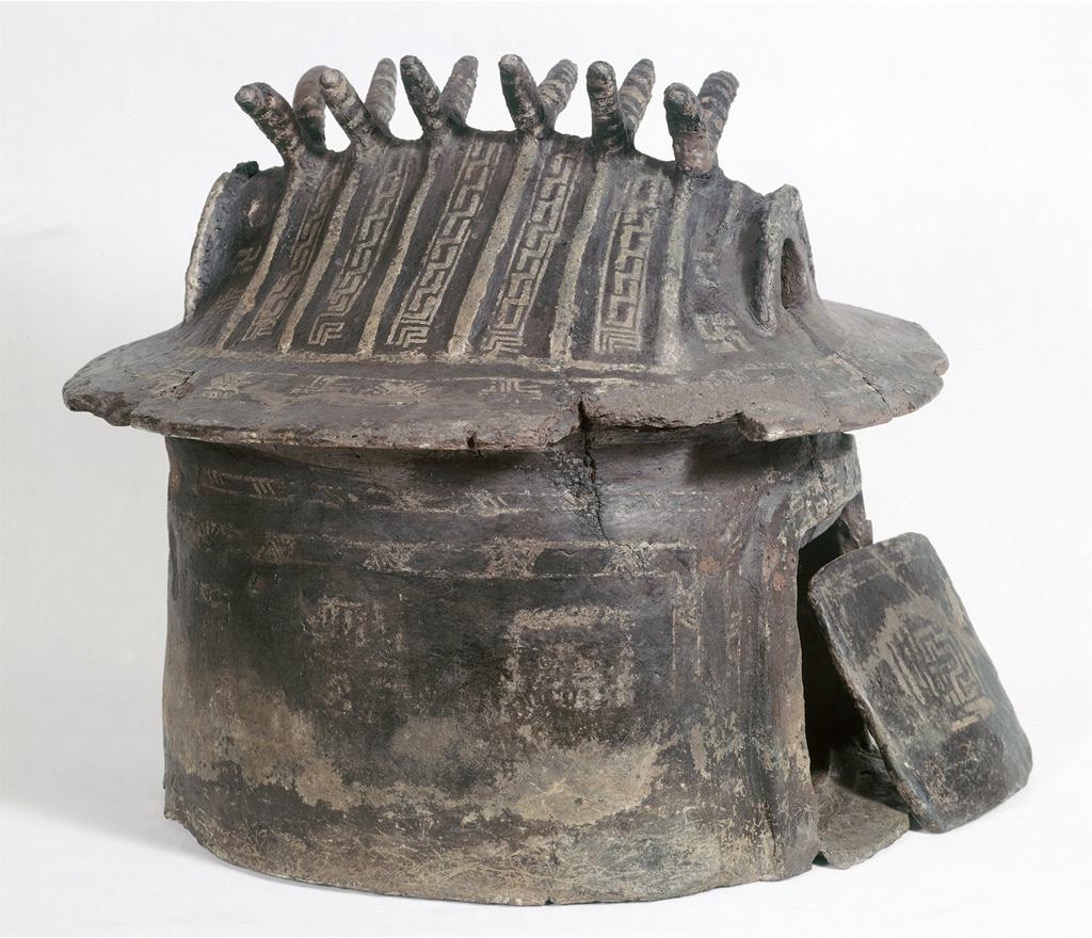
Hut Urn, Villanova, ca 900-800 BCE, used in settlements for the dead, replicates homes that were built, can be seen later in Rome, usually made of terracotta or bronze
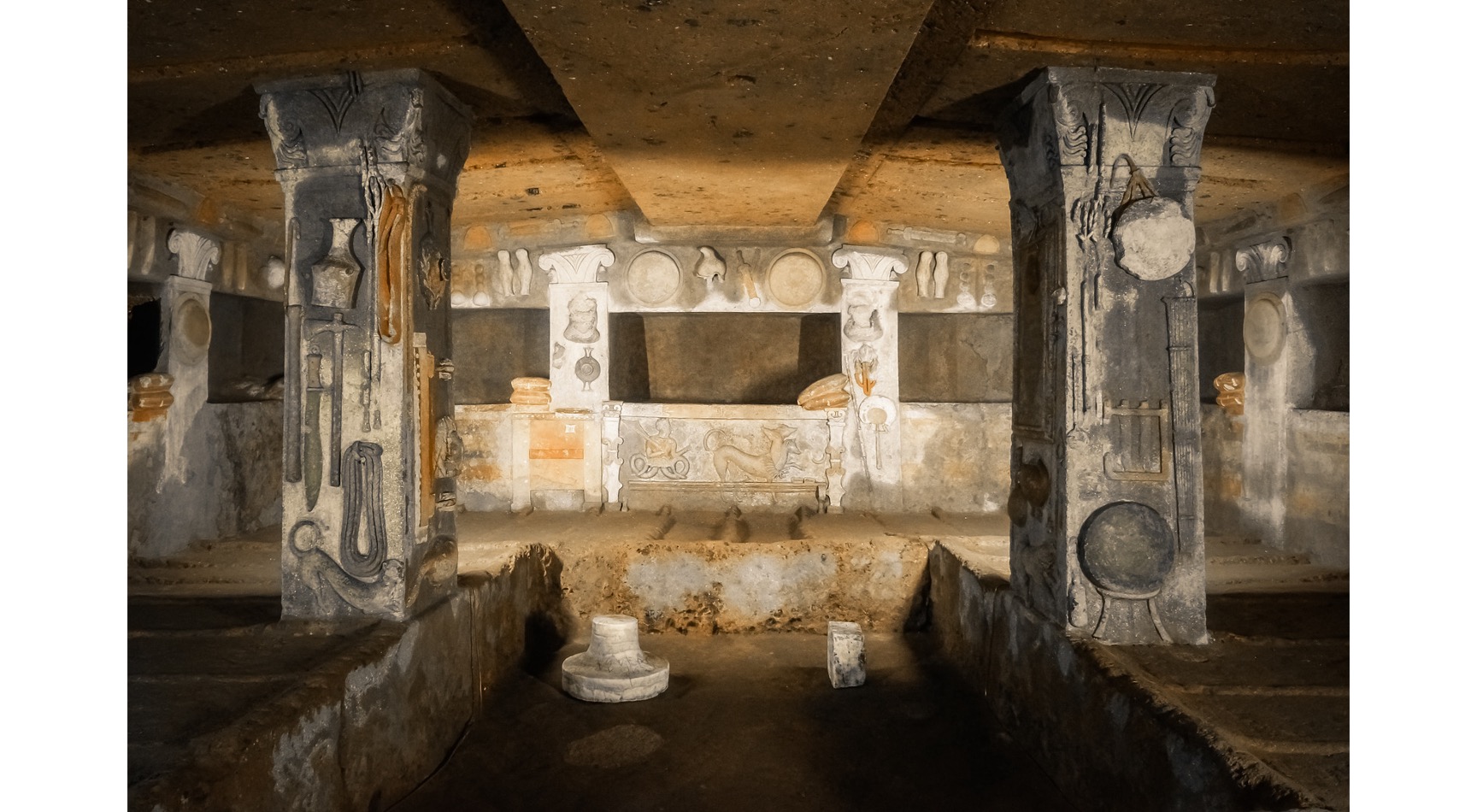
Cerveteri: Tomb of the Reliefs, Etruscan, mid 4th century BCE, most knowledge about Etruscans come from tombs, replicate homes and towns, Matuna family, Greek influence
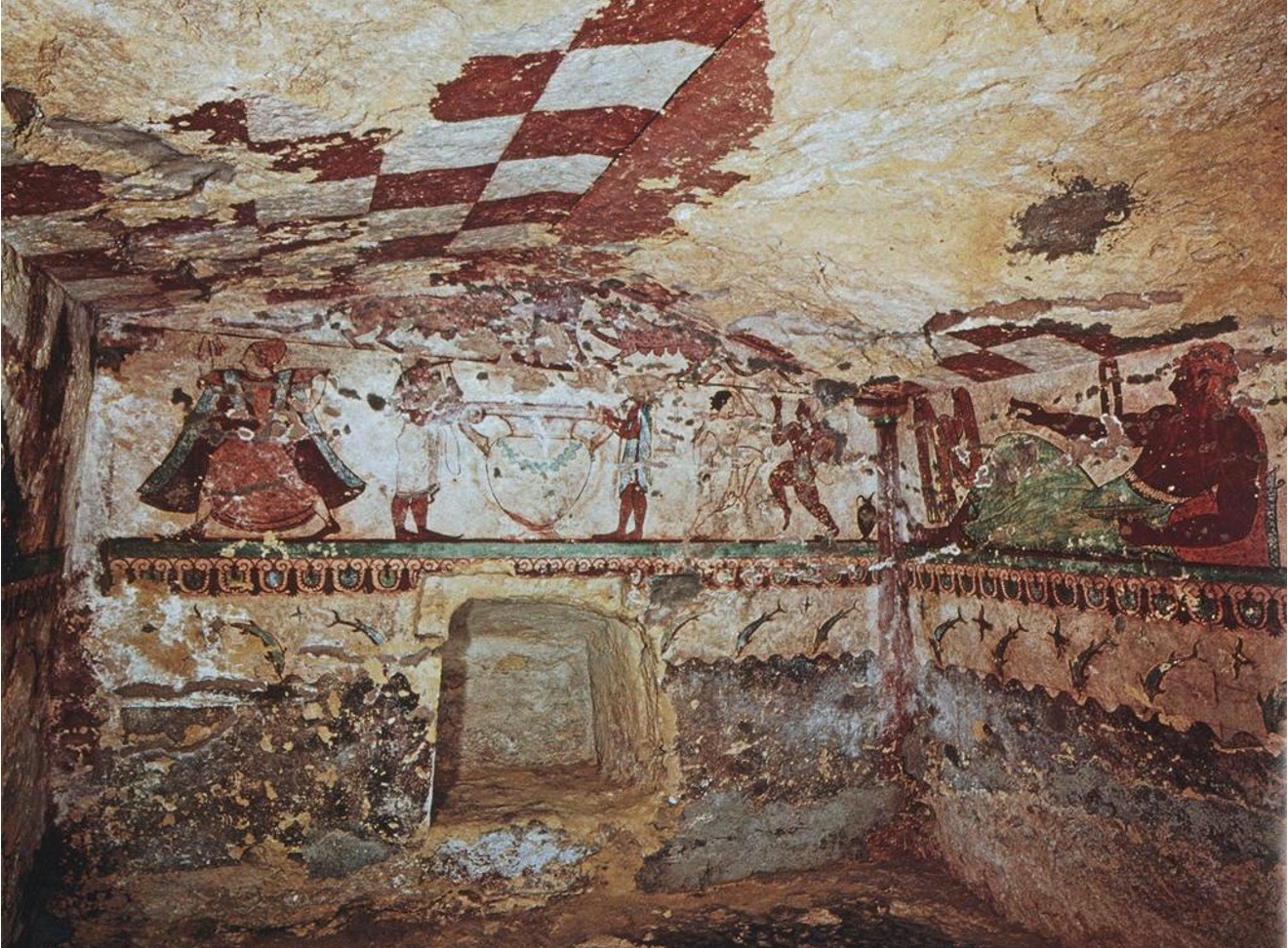
Tarquinia: Tomb of the Lionesses, Etruscan, ca 520-510 BCE, fresco painted tomb, owned by wealthy people, greek style painting with Etruscan subjects, showing a banquet, egg= resurrection, greek gods
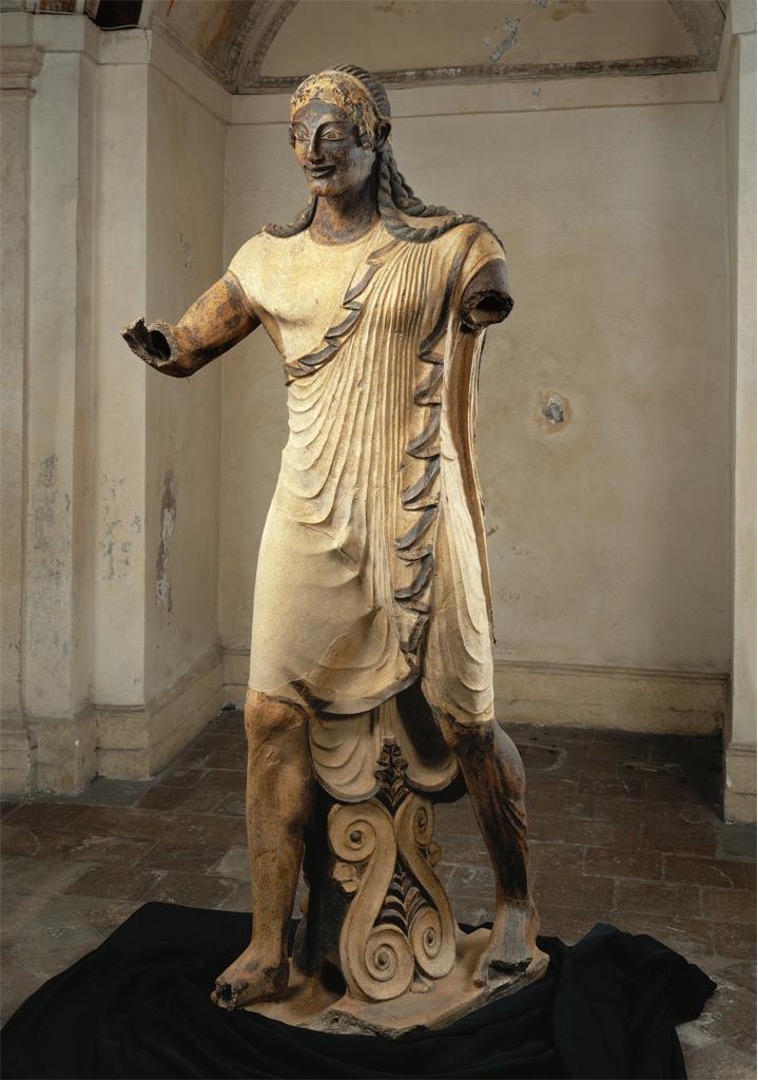
Veii, Portonaccio Temple: Apulu, Etruscan, ca. 515-490 BCE, terra-cotta, temple is dedicated to Menerva, who at this site may have had oracular and healing powers, fully clothed, unlike Greeks

Sarcophagus of the Married Couple from the Banditaccia Necropolis at Cerveteri, Etruscan, ca. 530-520 BCE, urn for a couple, shows intimacy, Greek influence
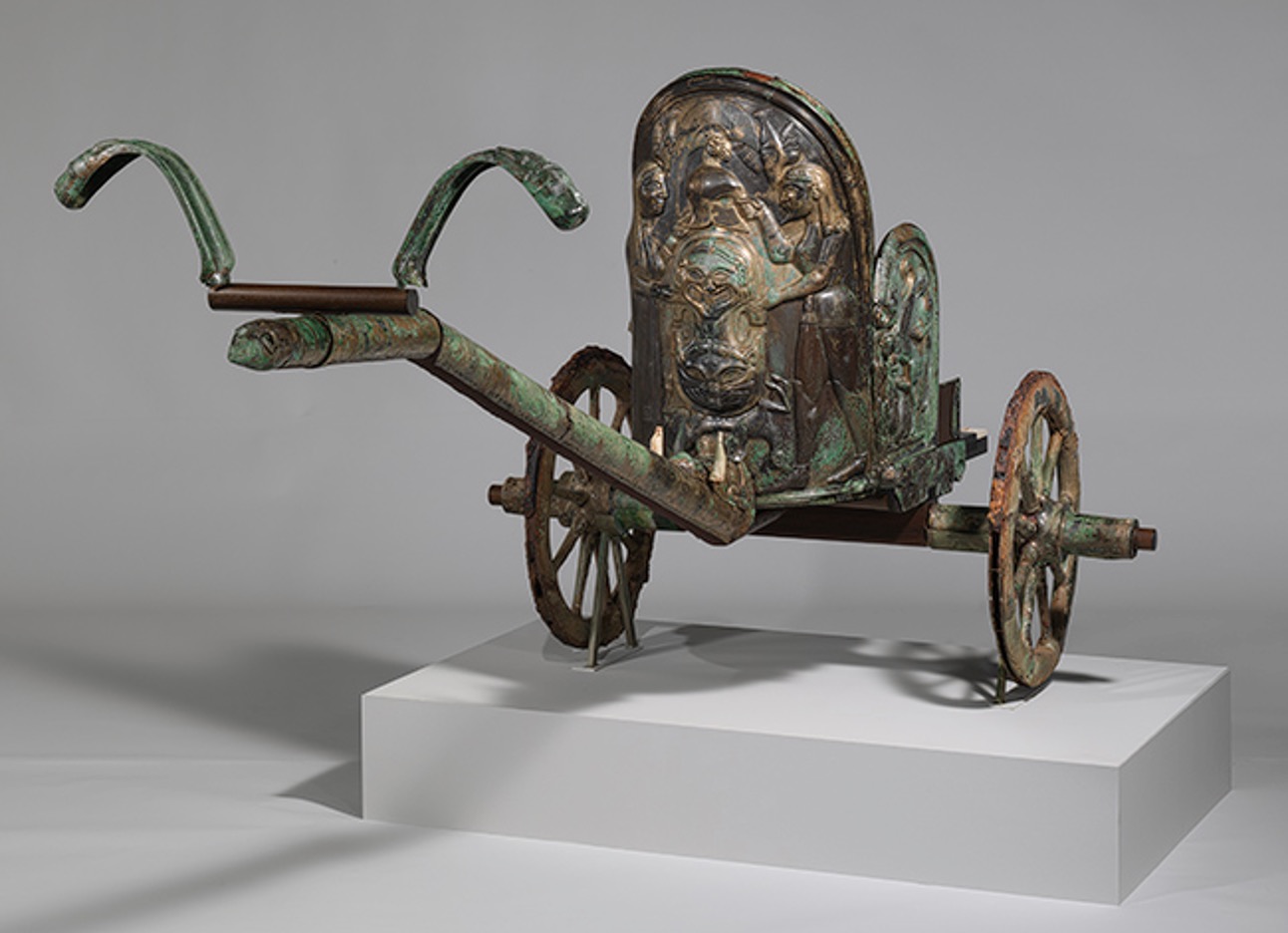
New York: Chariot from Monteleone, Etruscan, ca. 575-550 BCE, shows increasing quality of Etruscan metalwork, found in a tomb, three panels depicting life of Achilles, Etruscan used Greek gods and stories

Mars of Todi, Etruscan, ca. 400 BCE, lost wax bronze, Etruscan clothing, damaged from a lighting strike and buried, trying to be contrapposto
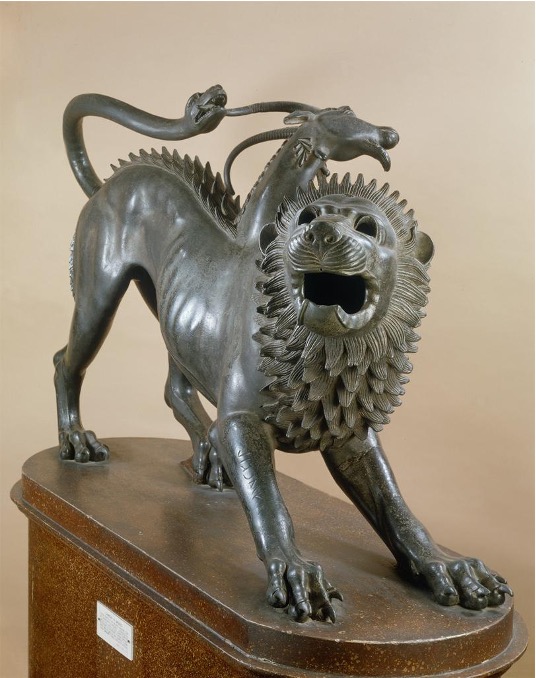
Wounded Chimaera from Arezzo, Etruscan, ca. 400 BCE, bronze, was buried outside the San Laurentino Gate of Arezzo, greek monster, representing invasion by Romans?
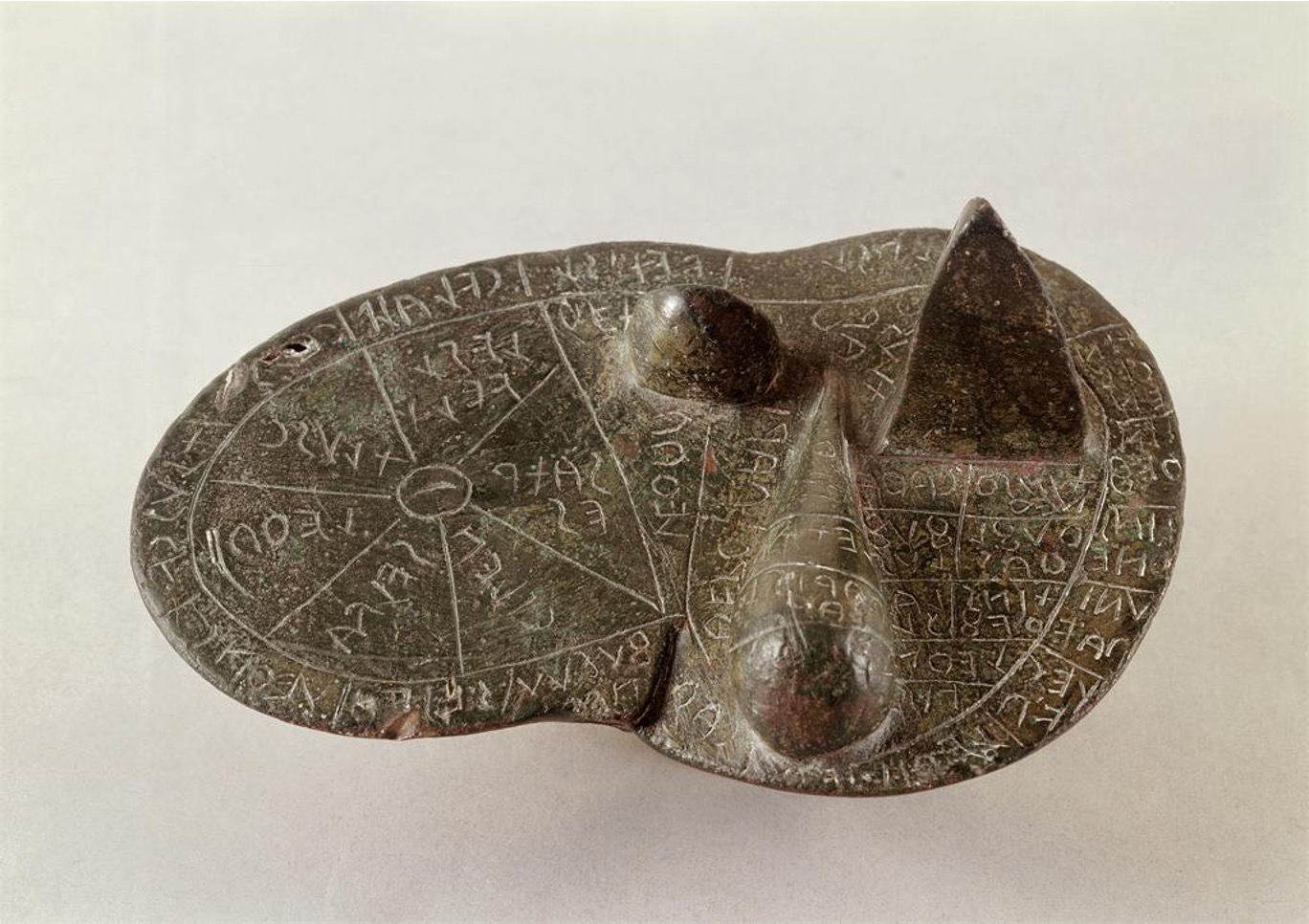
Bronze liver of Piacenza, Etruscan, ca. 100 B.C., Romans inherited the practice of haruspicy from the Etruscans, divination from the inspection of the entrails of sacrificed animals, sheep liver guide for haruspicy
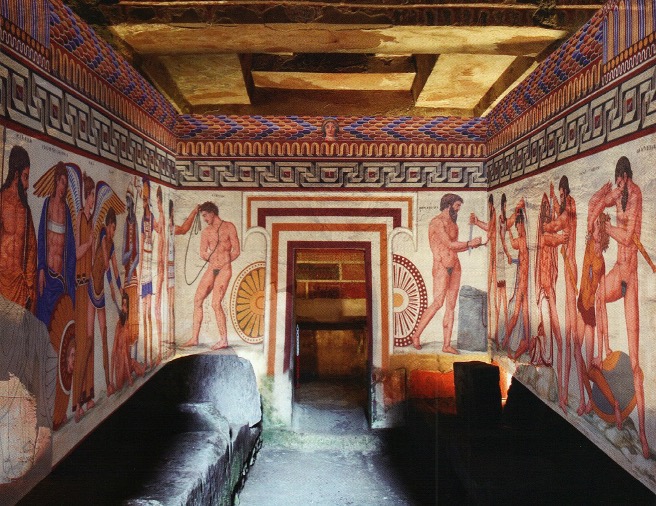
Vulci, François Tomb: the Heroes of Vulci Against Their Enemies, Etruscan, ca. 330-310 BCE, greek epics/myths as well as Etrusco-Roman history,
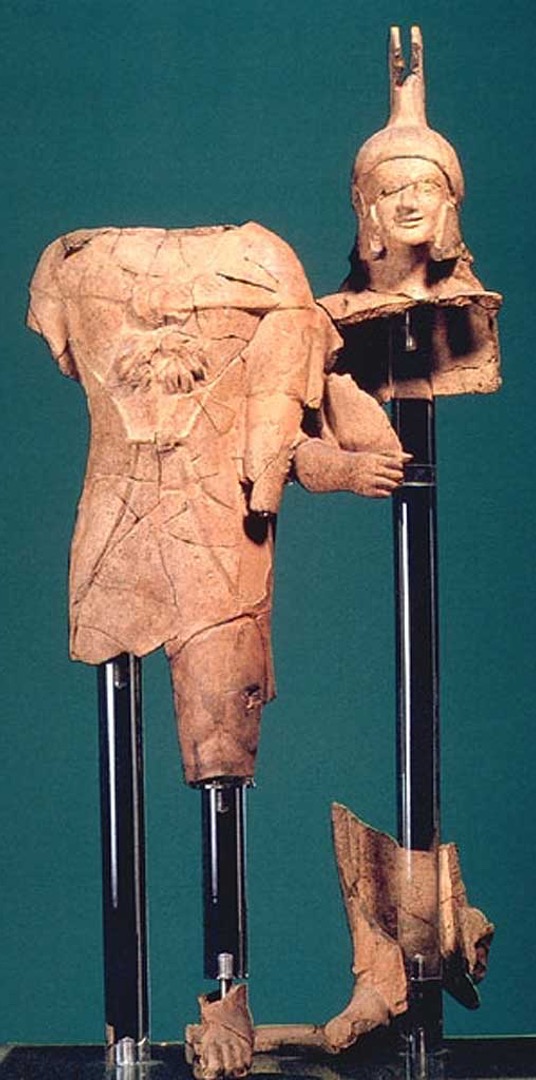
Rome, Sanctuary of Sant’Omobono: Herakles and Athena acroteria, Roman,
ca. 540-530 BCE, terracotta statues from temple in port of Rome, rebuilding by Tarquinius Superbus

Rome: Temple of Jupiter Optimus Maximus,
Roman, ca. 570-509 BCE, Capitoline Hill, begun by Tarquinius Priscus, mostly constructed by Tarquinius Superbus, terra-cotta statues, contentious size, debated to this day,
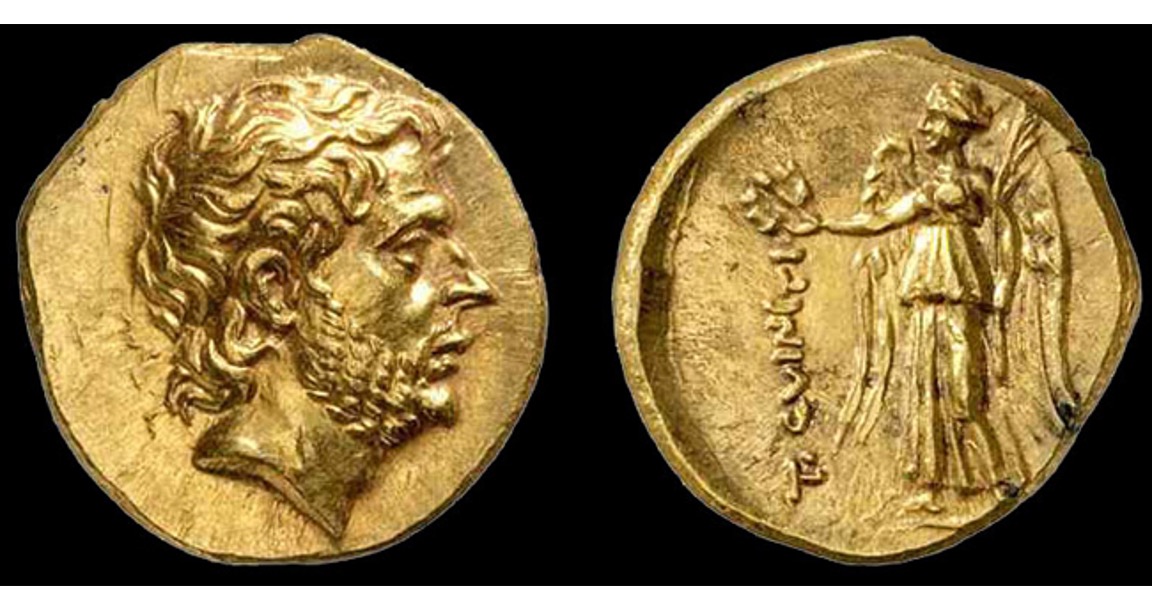
Coin of Titus Quinctius Flamininus, Republican, 197 BCE, for most of the Republican era Rome went to war every year, political candidates were typically required to have many years of military service, veterans were given land in colonies, including Greece, where Roman generals were regarded as kings by Greek people, Titus Quinctius Flamininus is portrayed in Hellenistic style, long hair and beard
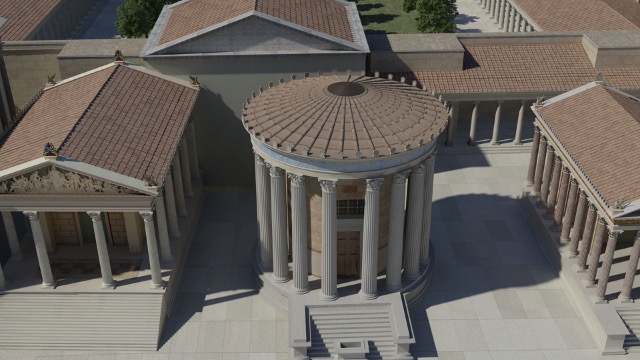
Rome: Republican Temples of Largo Argentina, Republican, early 3rd-2ndcenturies BCE, celebration of victories generals included procession, included many people, soldiers were not allowed armed in city, but it did not feel like enough for the generals, so they did victory arches, coins and manubial temples on the triumphal route, dedicated to deities of their choice, usually filled with their spoils of war, built with greek architectural orders
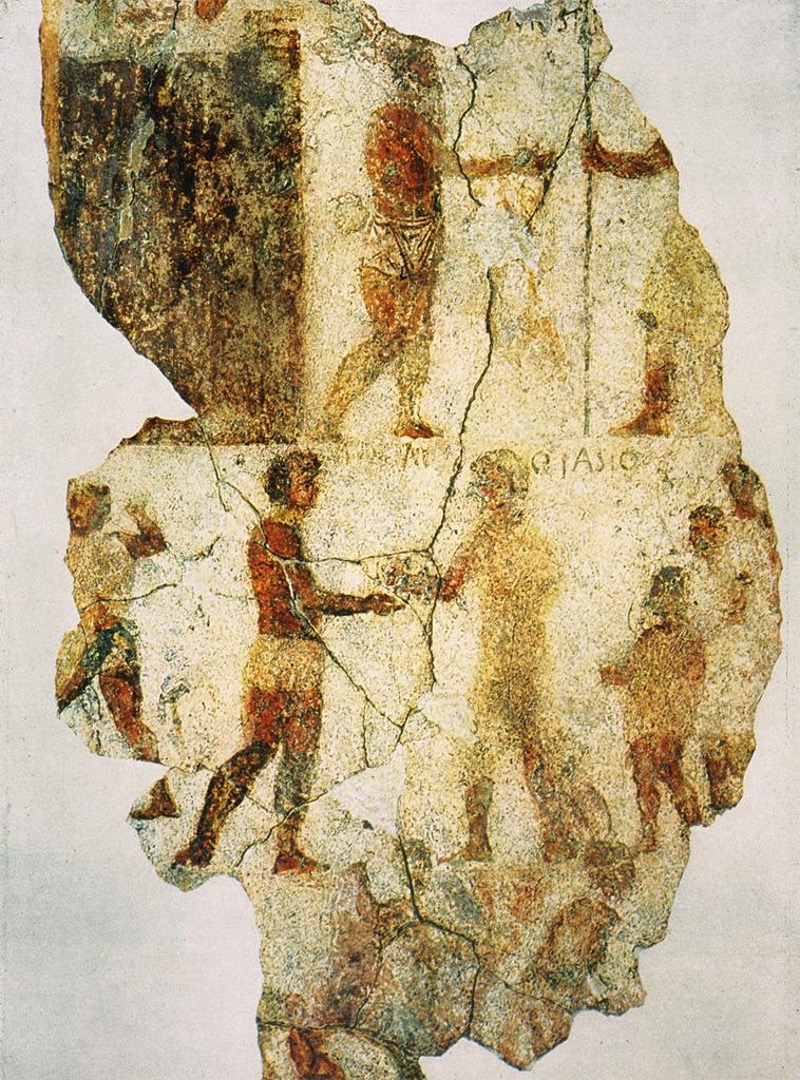
The Esquiline Fresco: Treaty between Fannius and Fabius,
Republican, 3rd century BCE, earliest surviving wall painting fragment of Rome, founded on Esquiline Hill, it is divided into registers/sections, Fabius is probably Quintus Fabius Maximus Rullianus, who commanded Rome’s cavalry force during the Second Samnite War, likely depicting a treaty after the war, includes hierarchal scale, nonrealistic,
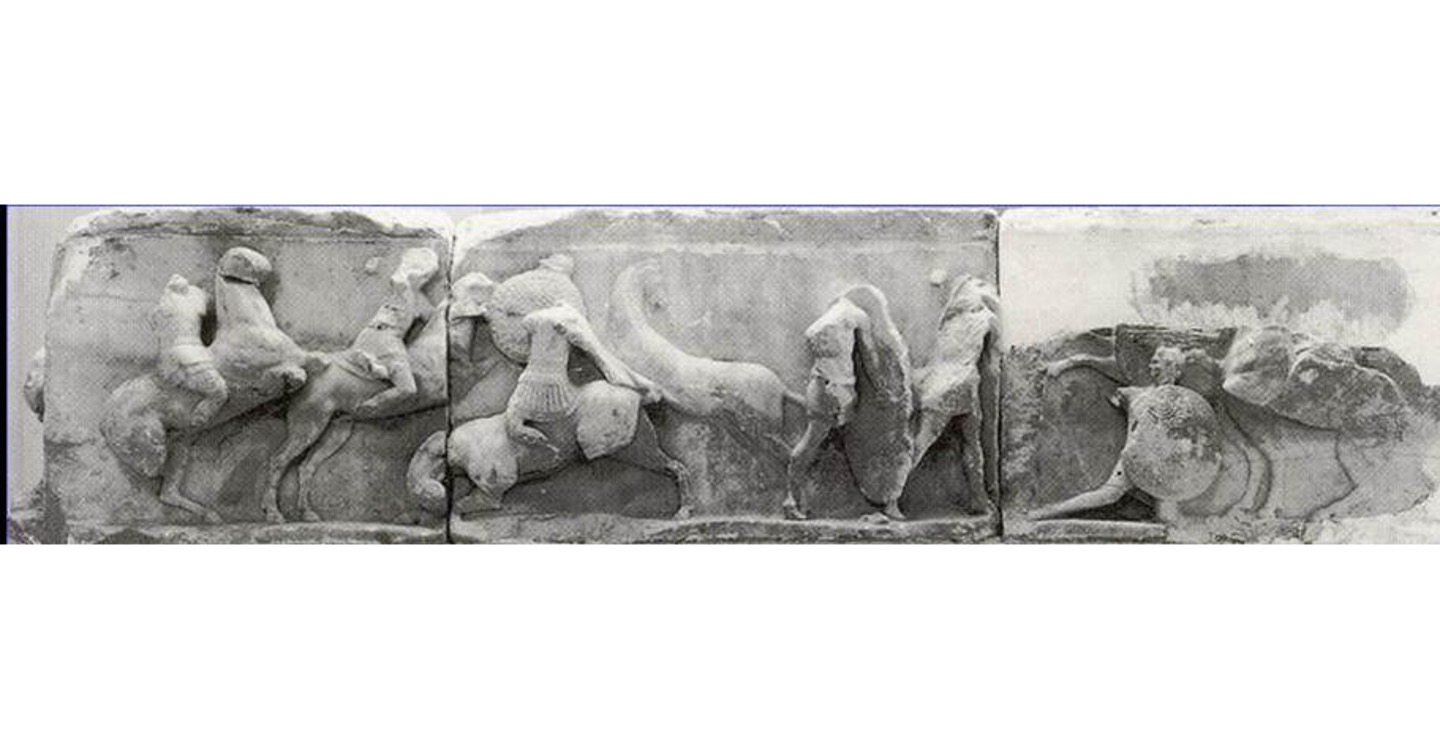
Delphi, The monument of Aemilius Paullus: The riderless horse, Republican, 168-167 BCE, commemorate Aemilius Paullus’ victory over Perseus, king of Macedonia, at the Battle of Pydna in 168 BCE, Roman victory over Macedonia in Third Macedonian War, Paullus ordered that this pillar, which was already being built, be converted to a monument of him, fragmentary frieze at the top of the pillar, depicts the contemporary war, horse with no rider runs into battlefield,

Relief from the Piazza della Consolazione: Roma on a Shield Between Trophies, Republican, 2nd-1st c. BCE, relief that was likely the base of a statue, showing military gear, like Hellenistic, shows Roma- female greek deity personification of Rome,
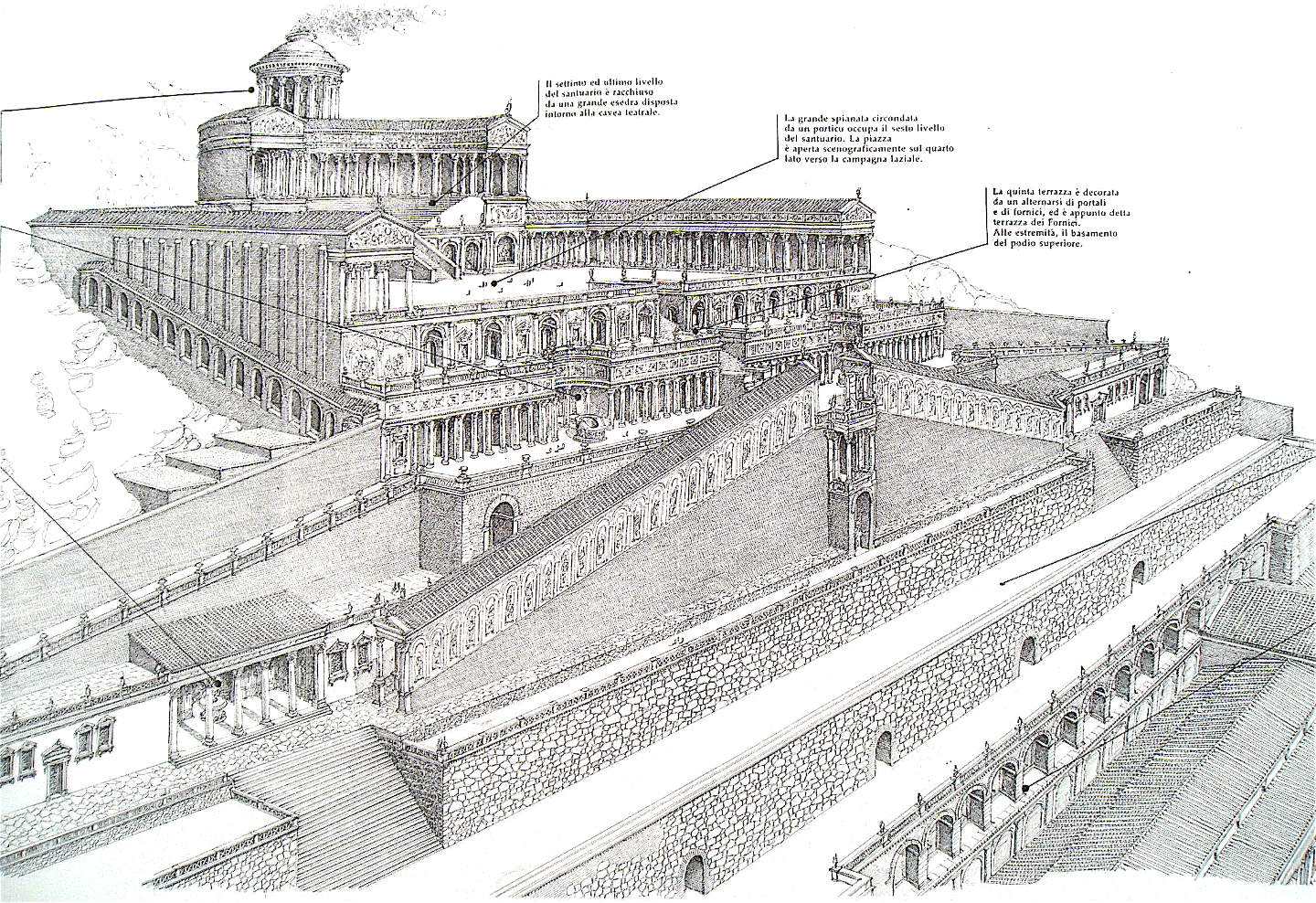
Praeneste: Sanctuary of Fortuna Primigenia, Republican, 2nd-1st c. BCE, Romans began using vaults and concrete to build larger buildings, for the goddess Fortuna, founded by pre-Sullan old families of the city of Praeneste, advanced, symmetrical design
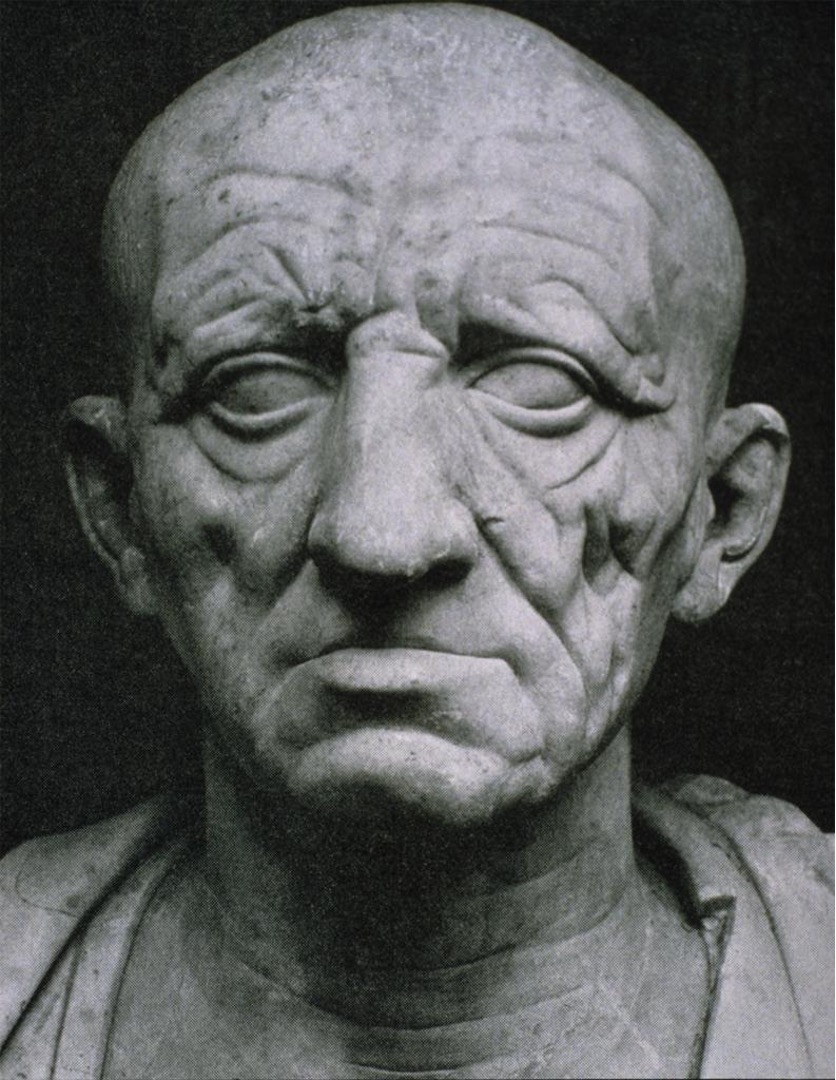
Torlonia: Portrait of an Old Man, Republican, ca. 80-50 BCE, romans did full figures and busts, unlike greeks, and were not idealized faces
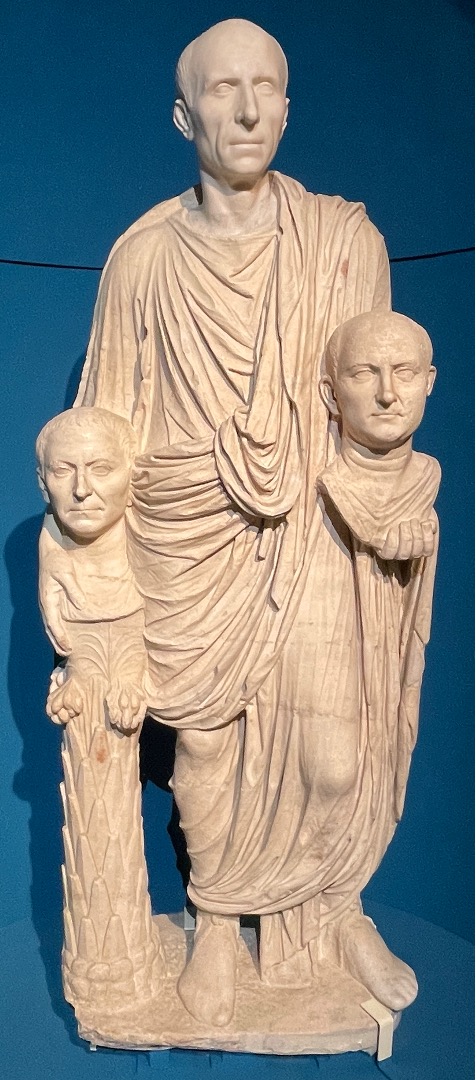
Togatus Barberini
(Man with portraits of his ancestors),
Republican, late 1st c. BCE, man carrying terracotta or wax busts of his ancestors, distinguished roman lineage
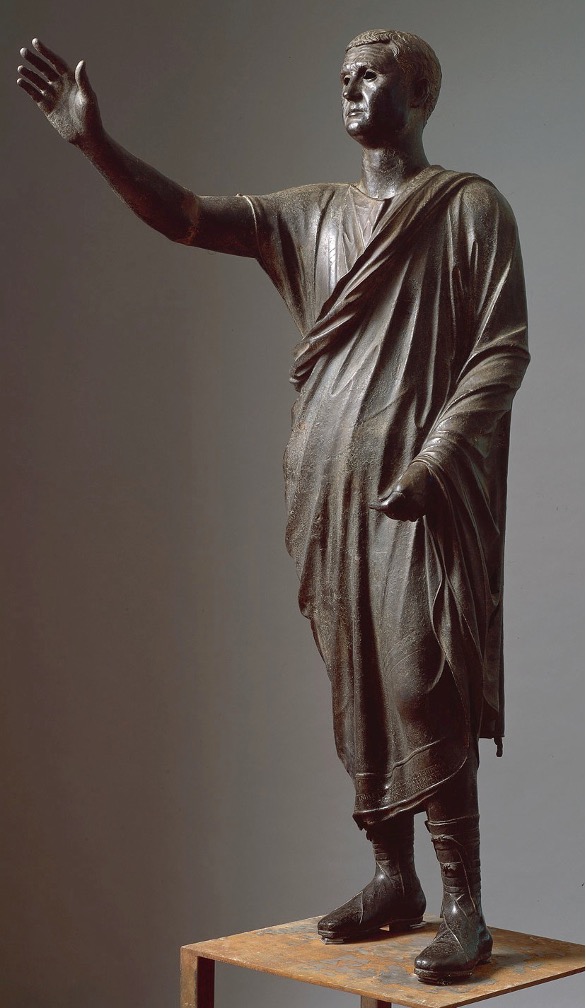
The Arringatore (“Orator”), Republican, late 2nd century BCE, Found in 1573 in the vicinity of Lake Trasimeno, most likely for a public place, gesture of addressing the public, lost wax method, many pieces put together, statue is dressed in Roman attire, with Etruscan inscription on toga,
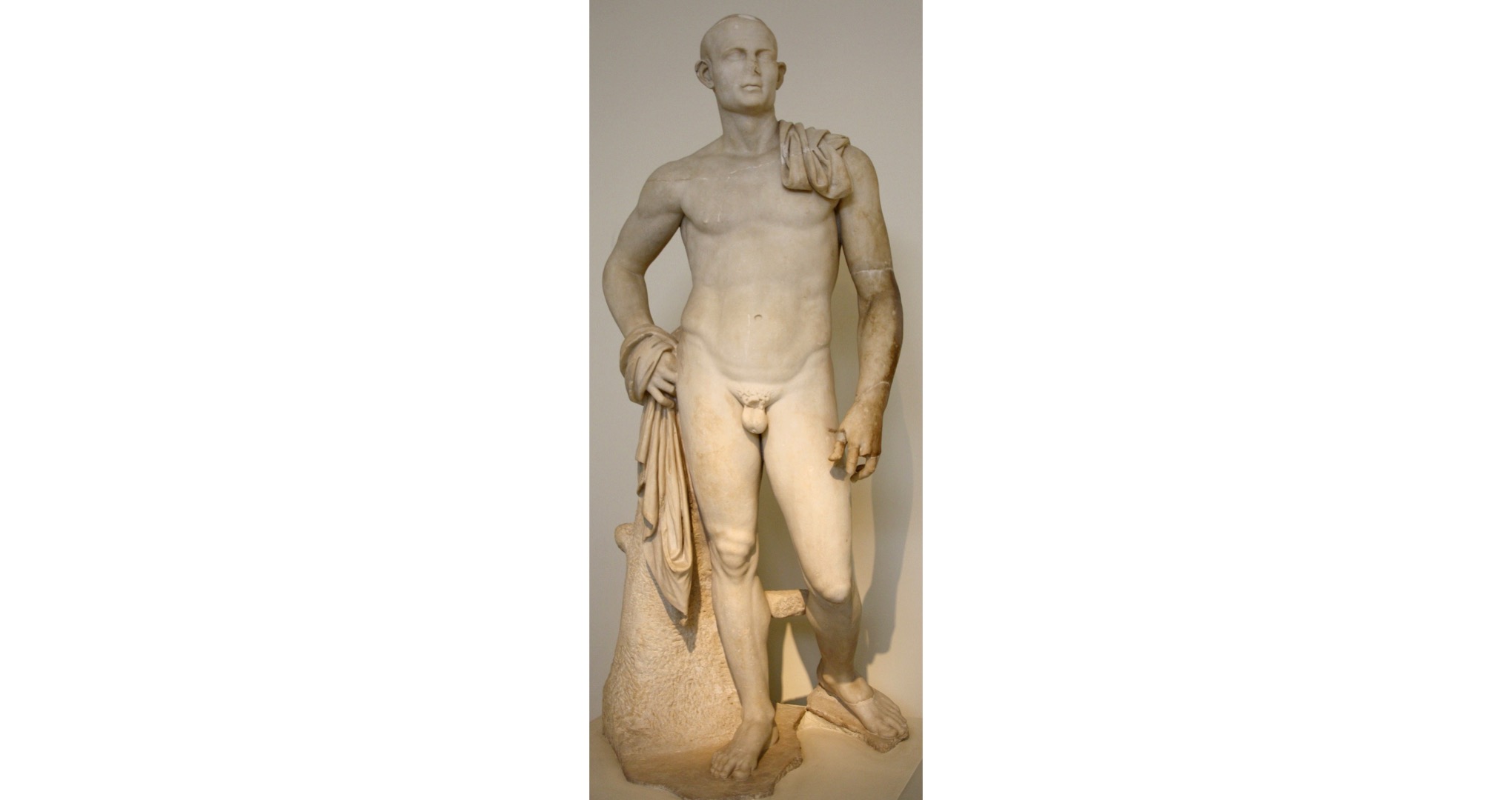
The Pseudo-Athlete from Delos, Republican,
early 1st c. BCE, found in House of the Diadoumenos on the Greek island of Delos, shows roman man depicted nude, mature face, idealized body,
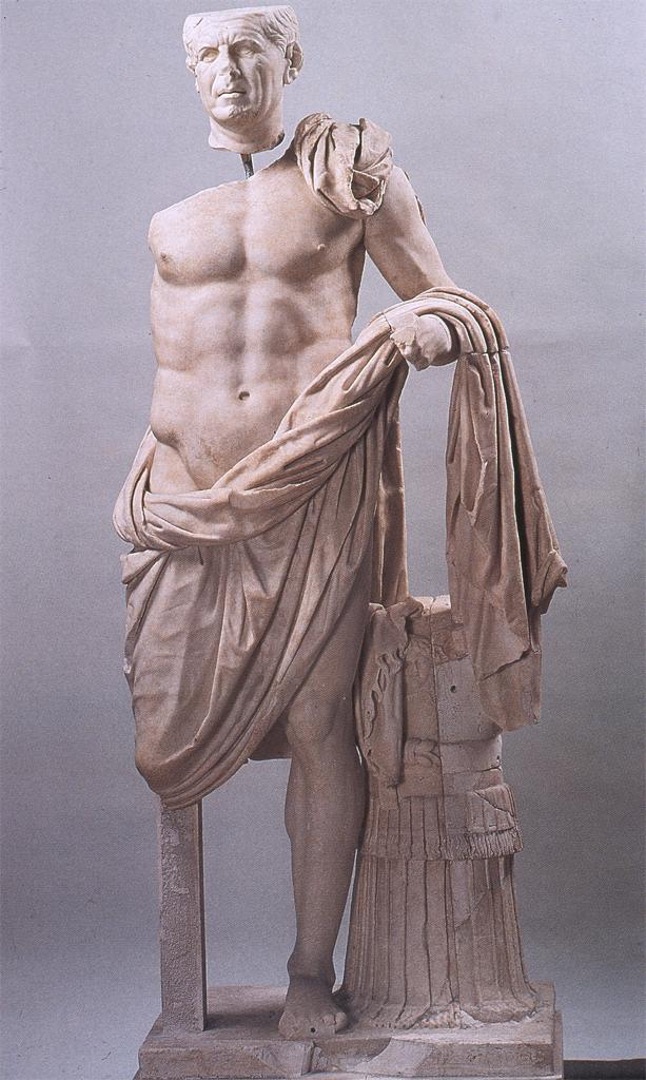
The Tivoli General, Republican, ca.75-50 BCE, mix and match mass produced sculpture made for order, was found in the Sanctuary of Hercules Victor at Tivoli, hip-mantle style of dress, The statue support, set beside the figure's left leg is a Hellenistic leather cuirass, identifying him as a military man.
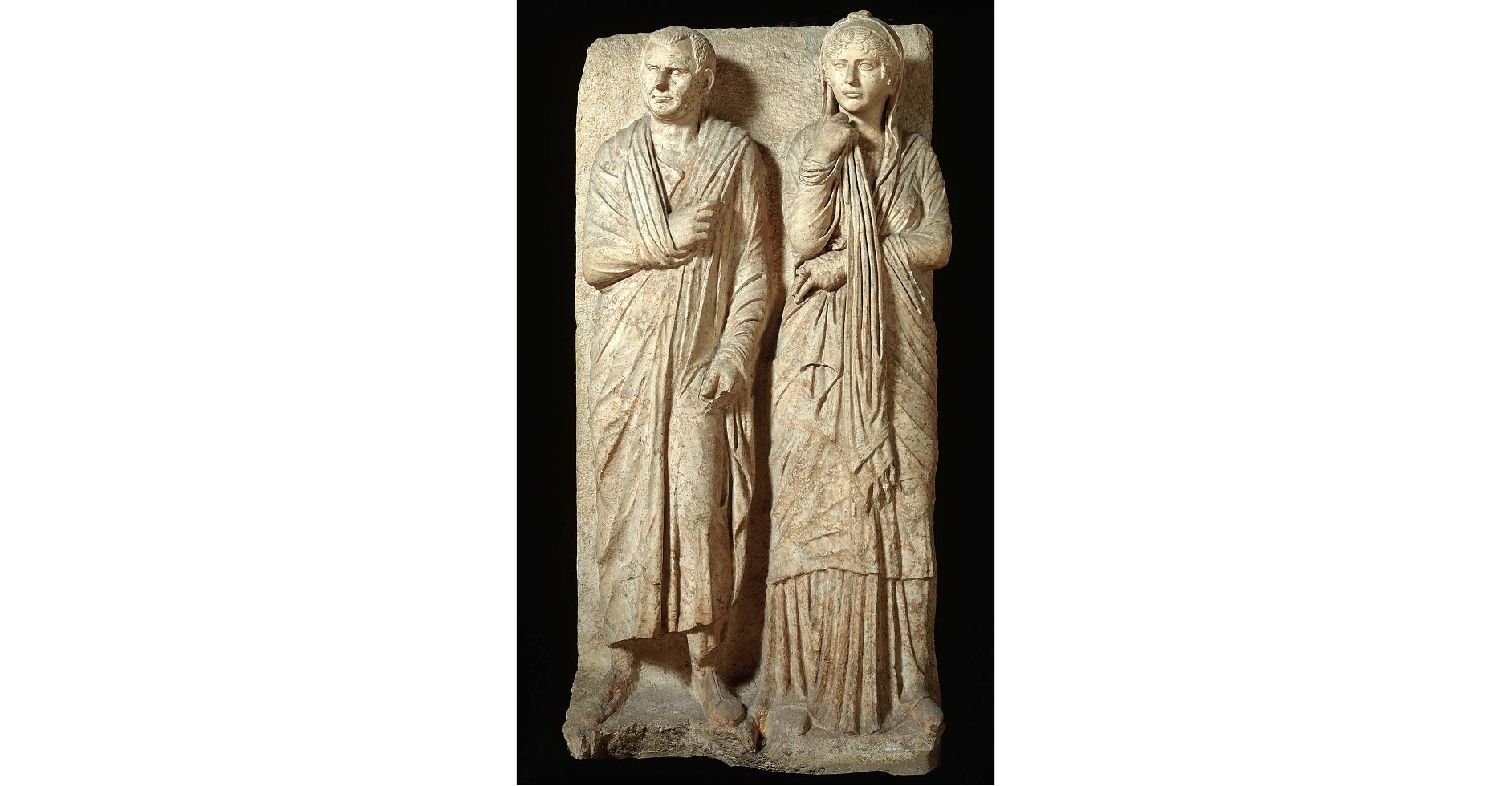
Gravestone from the Via Statilia, Republican, ca. 70-60 BCE, full-length figures carved in high relief on vertical tombstones, faces are individualized, man is in Roman dress, woman is in Hellenistic dress, no touching between them

Funerary relief of a couple found on the Via Appia, Republican, ca. 30-20 BCE, shows a freed slave and his wife, gesture of the clasped hands is known as dextrarum iunctio, means that the marriage was legit
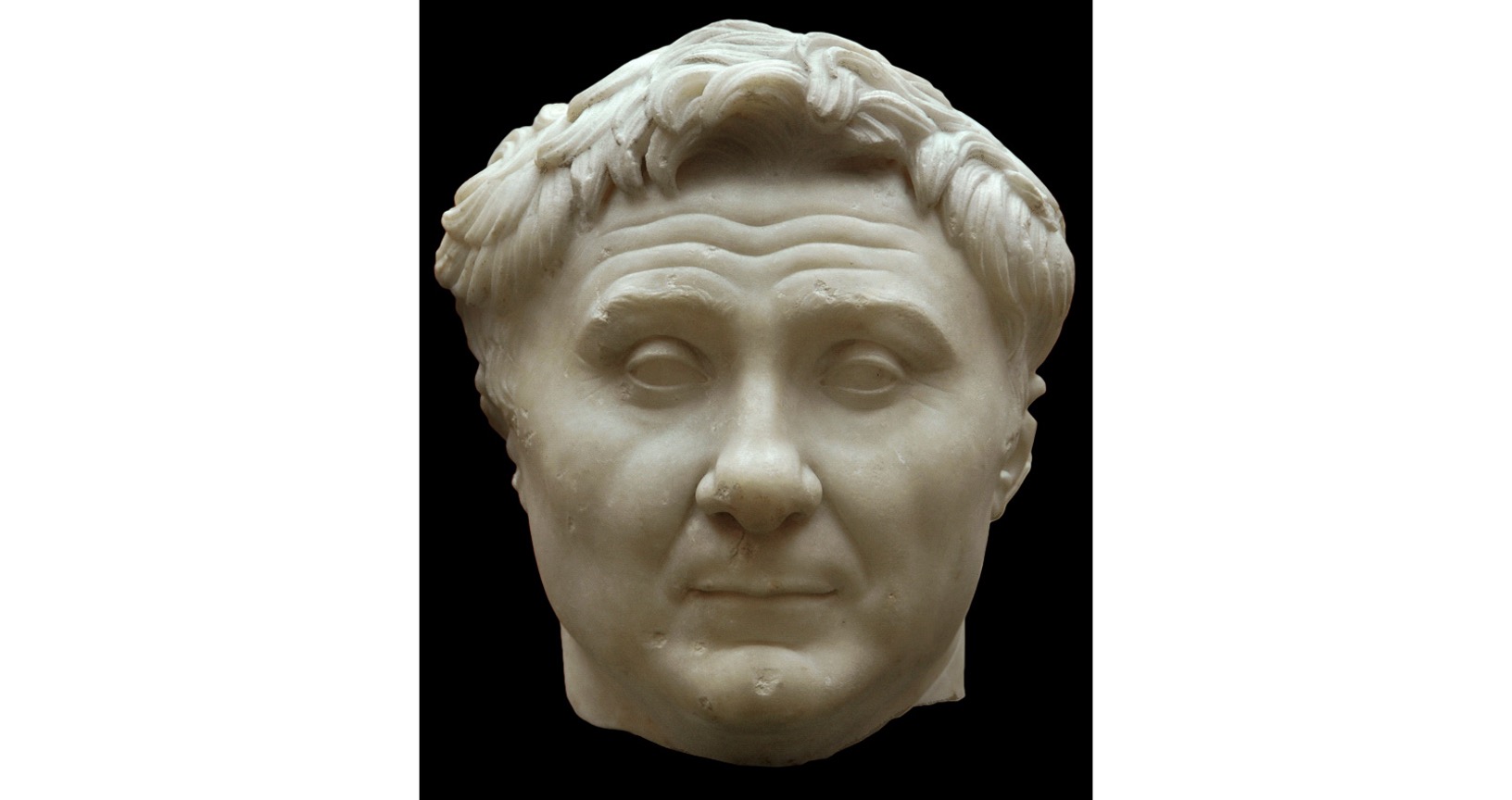
Portrait of Pompey, Republican, ca. 80 BCE, shows all of the imperfections, anastole (cowlick, Alexander the Great/ lion reference), earliest surviving Roman portrait that deliberately associates its subject with an earlier historical personage. Pompey wore Greek clothing, Pompey built Rome’s first permanent theater, the earliest known use of opus quadratum masonry, included integrated cavea (seating) and stage, elaborate backdrop known as the scaenae frons, included at its apex a shrine to Venus Victrix, his patron goddess, to help lessen senatorial resistance to a permanent theater

Marcus Antonius Base, Formerly called the “Altar of Domitius Ahenobarbus”: Census Relief, Republican, early 1st c. BCE, one of four reliefs that appears to have decorated a large statue base, other three show a wedding procession of Poseidon, On this relief, a more straightforward narrative style in the contemporary Roman mode was used for the Roman scenes of census and sacrifice, carved from greek marble, but is a very roman style relief, left side is census in Temple of Nymphs, for tax and military purpose, on right is Altar of Mars, where a sacrifice is happening, found near the Circus Flaminius, an area crowded with manubial temples- thought to be built by the Ahenobarbus family after naval victory, due to a passage written by Pliny, however they never served as consuls, censor must be Marcus Antonius because in 102-100 BCE he won a naval battle and in 97/6 BCE he was named censor.
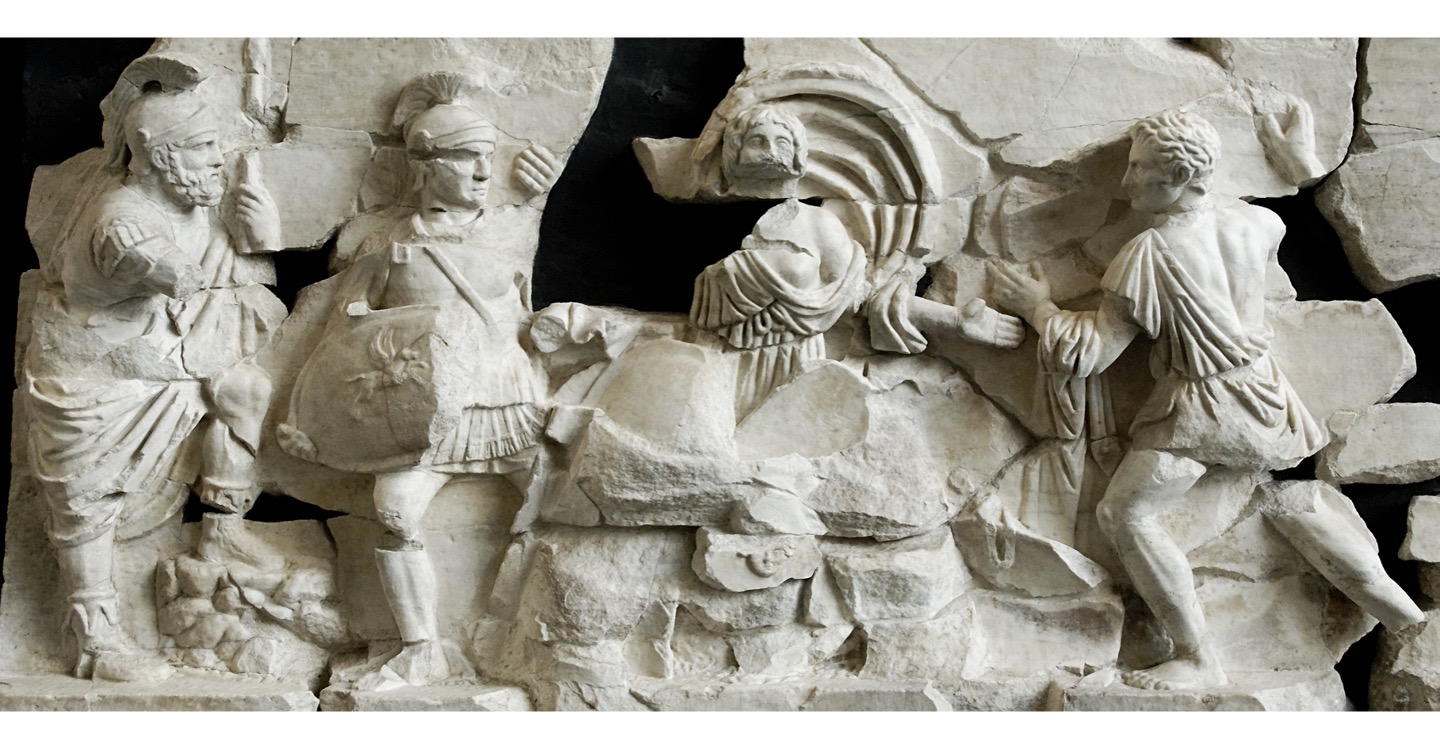
The Basilica Aemilia: the Punishment of Tarpeia, Republican, mid 1st c. BCE, was part of a longer frieze that once decorated the Basilica Aemilia in the Roman Forum, probably its reconstruction that occurred in 55/54 B.C, the word basilica comes from Greek word for king, basilicas were likely to receive ambassadors and kings, frieze is about founding of Rome, Aemilius family wanted to trace their lineage back, Tarpeia is punished for letting Sabine attackers into Rome for their bracelets,
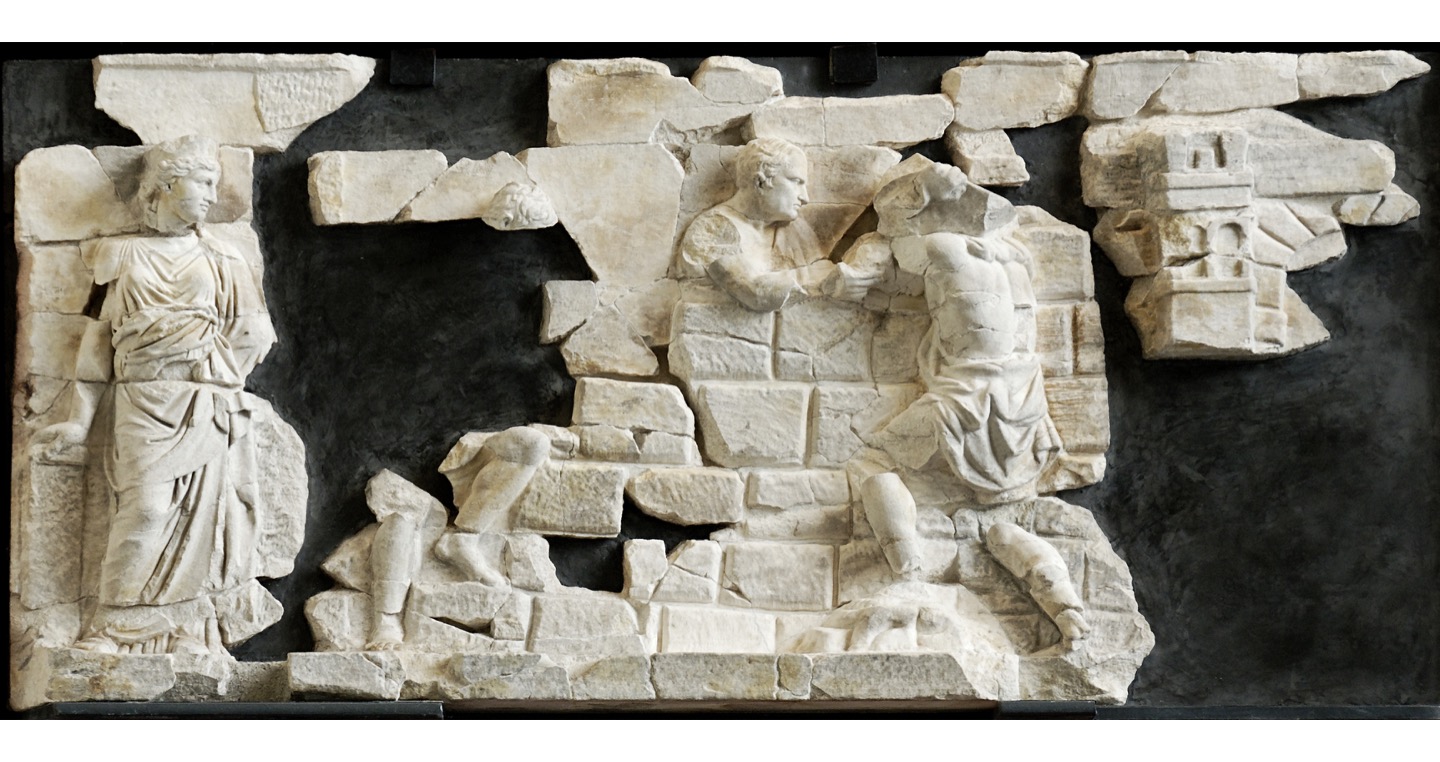
The Basilica Aemilia: Building a City, Republican,
mid 1st c. BCE, men build a city wall while a turret-crowned goddess watches, she is Lavinia or Alba Longa, embodiment of one of these cities, shows daily activities, men working hard
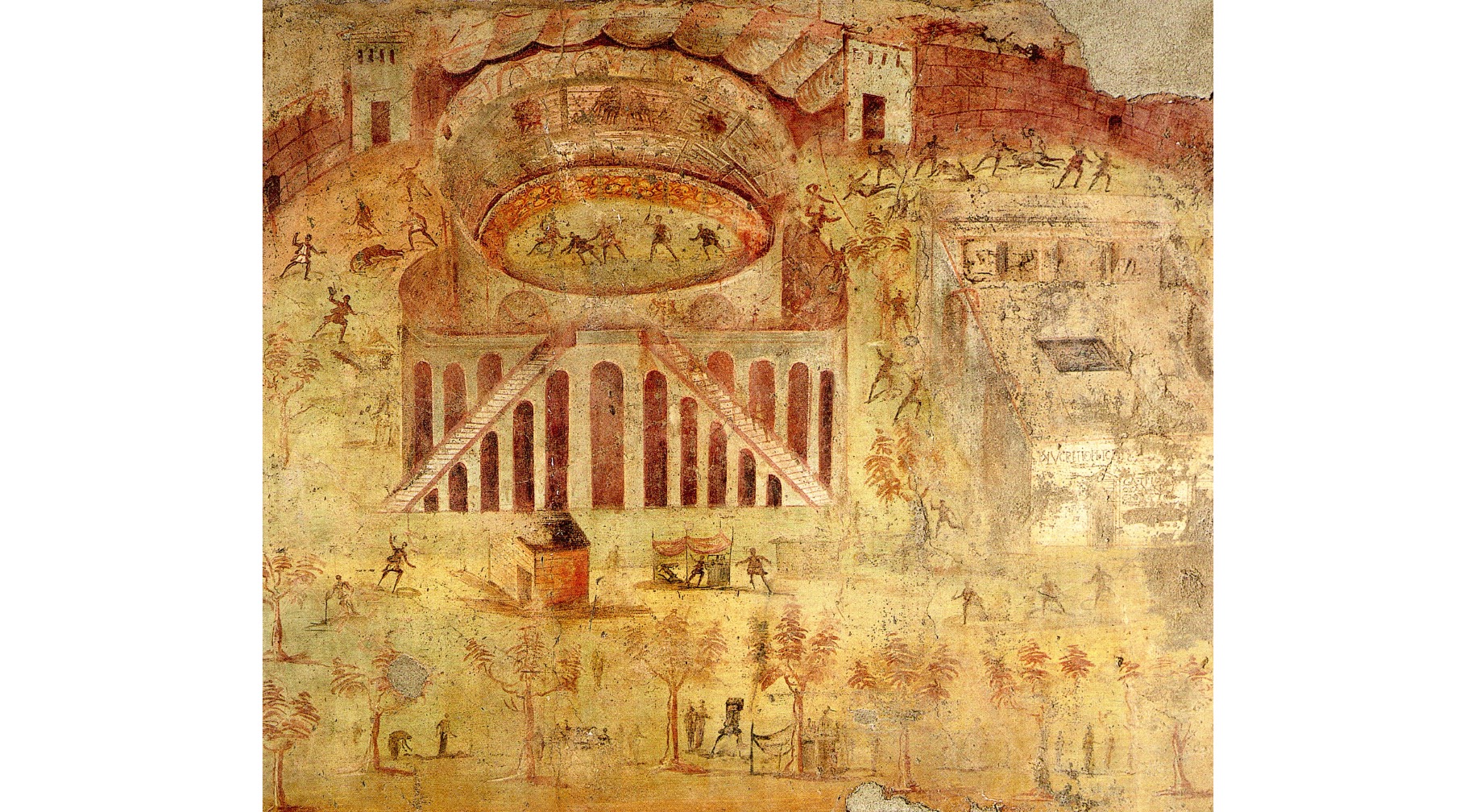
Pompeii: Riot in the Amphitheater Fresco, Julio-Claudian, 59 CE, a riot broke out in the amphitheater of Pompeii between the Pompeians and the people of neighnoring Nuceria during a gladiatorial show, emperor Nero forbade Pompeians from having these gatherings again for 10 years, fresco, found in a private home in Pompeii, dominating landscape, multiple viewpoints, flattened perspective
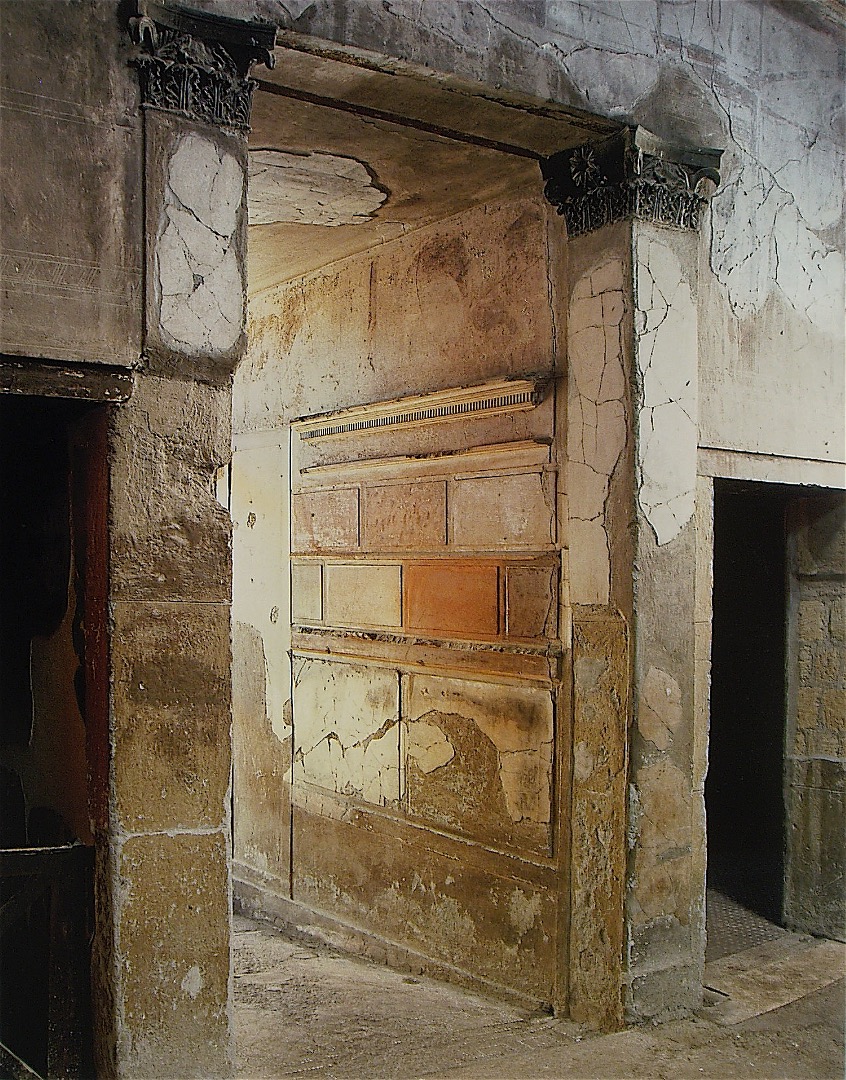
Herculaneum, House of the Samnite: Atrium (First Style), Republican,
2nd century BCE, Republican period, Romans began investing significantly in the décor of their homes, which were considered a semi-public place, first style- wall was painted to look like expensive colorful stone, but was stucco, August Mau was the first to distinguish stylistic periods in Pompeian wall painting
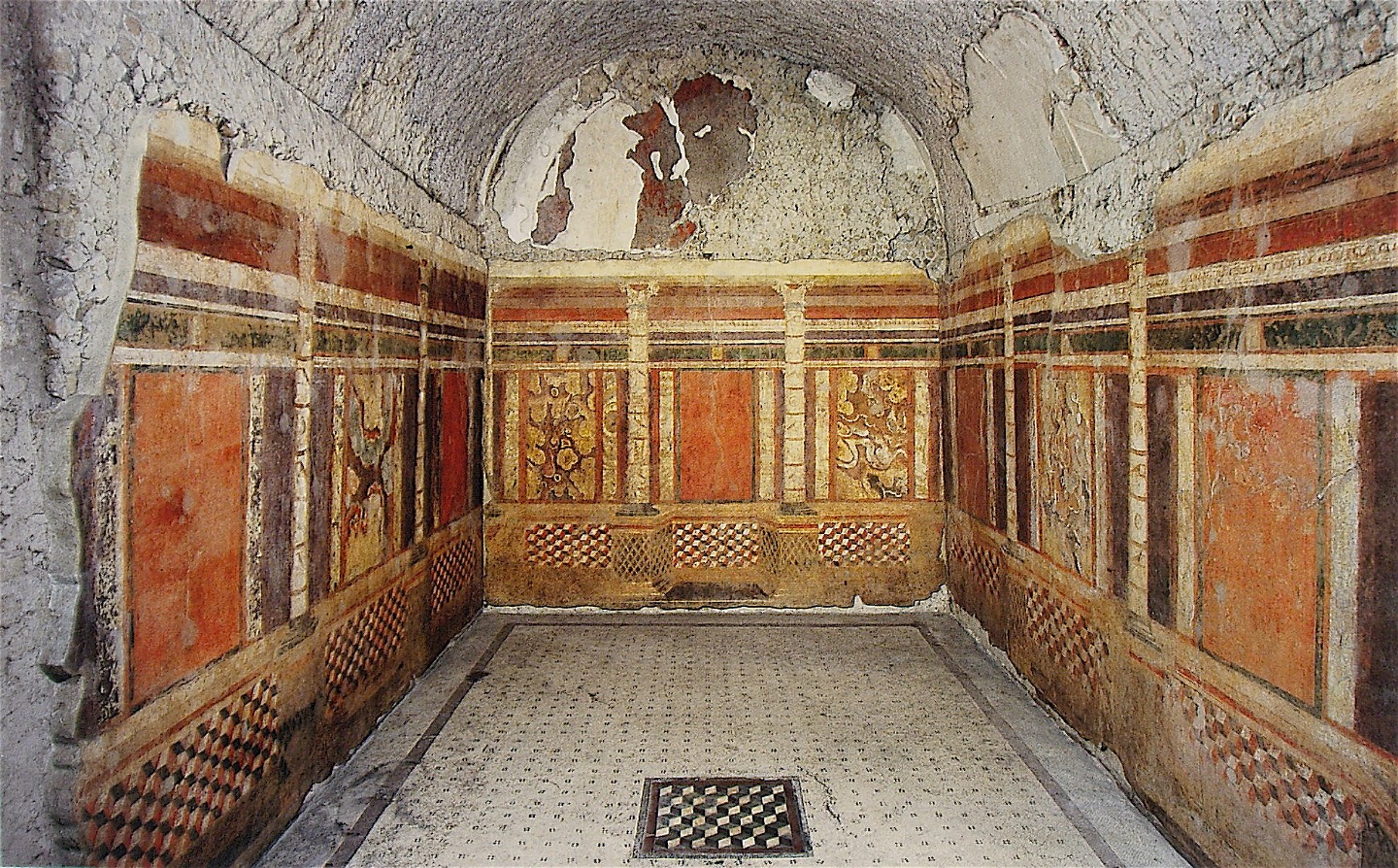
Rome, House of the Griffins: Room with marble incrustation (Second Style), Republican, ca. 100-80 BCE, on Palatine Hill, only first floor survives as original, second style, Second Style wall-painting appears to have developed in Rome around 100 B.C. and first appears in Pompeii around 80 B.C., when the Sullan veteran colony is established in the city, painted walls to look like there were no walls, The dado is composed of panels of cubes in perspective separated by column bases. This pattern is replicated in the small square panel made of inlaid marble in the center of the floor, a decorative technique known as scutulatum.
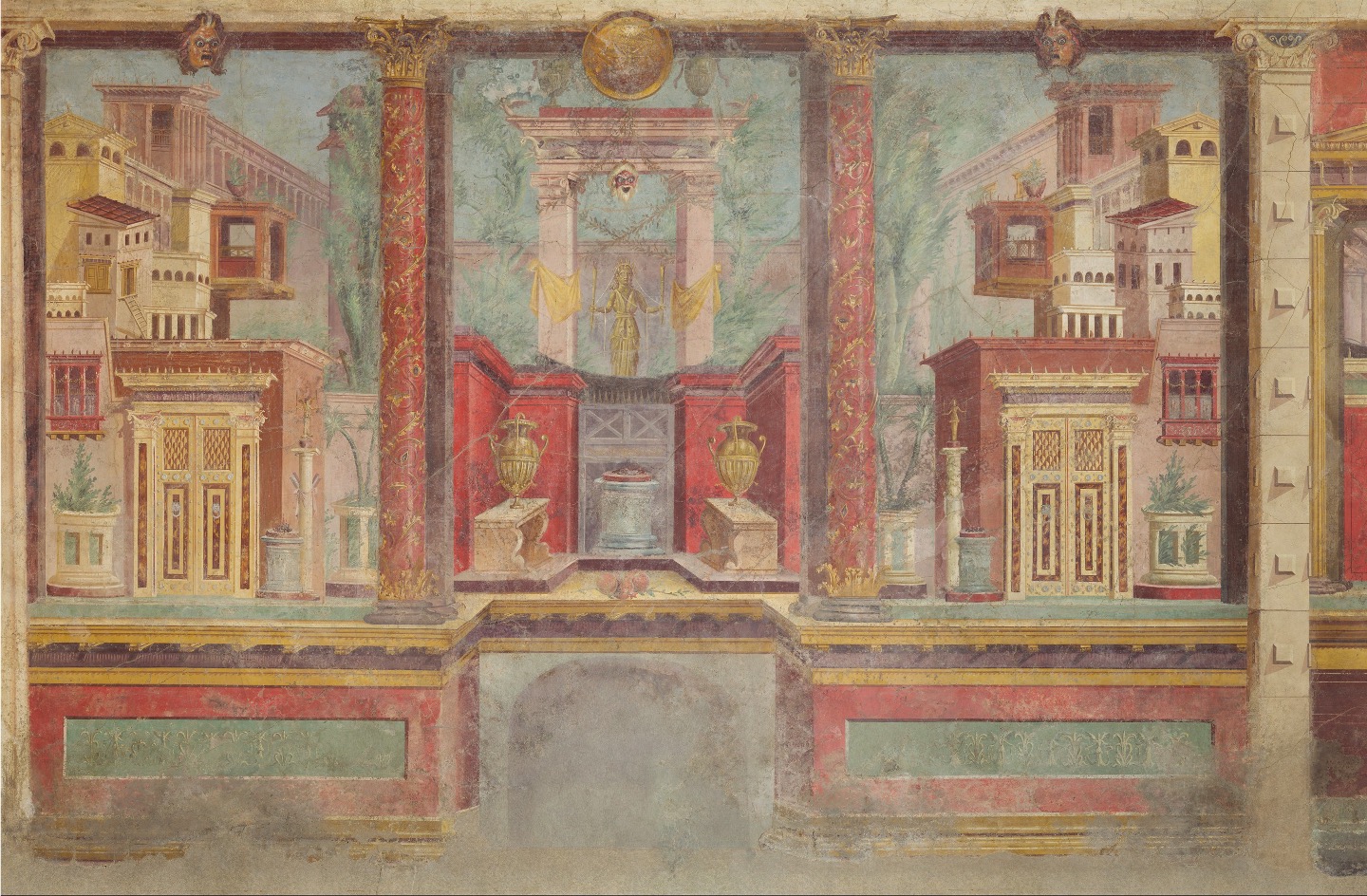
Boscoreale: Cubiculum, West wall- Shrine and Cityscape Triptych (Second Style), Republican, ca. 50-40 BCE, villa ~1 mile away from Pompeii, buried, second style, shadows on fresco match the natural lighting from the real window, “triptych” is created by Corinthian columns, their red shafts decorated with golden tendrils and gemstones and crowned by golden capitals, statues of creatures, statue of Diana, theatrical masks, herringbone perspective
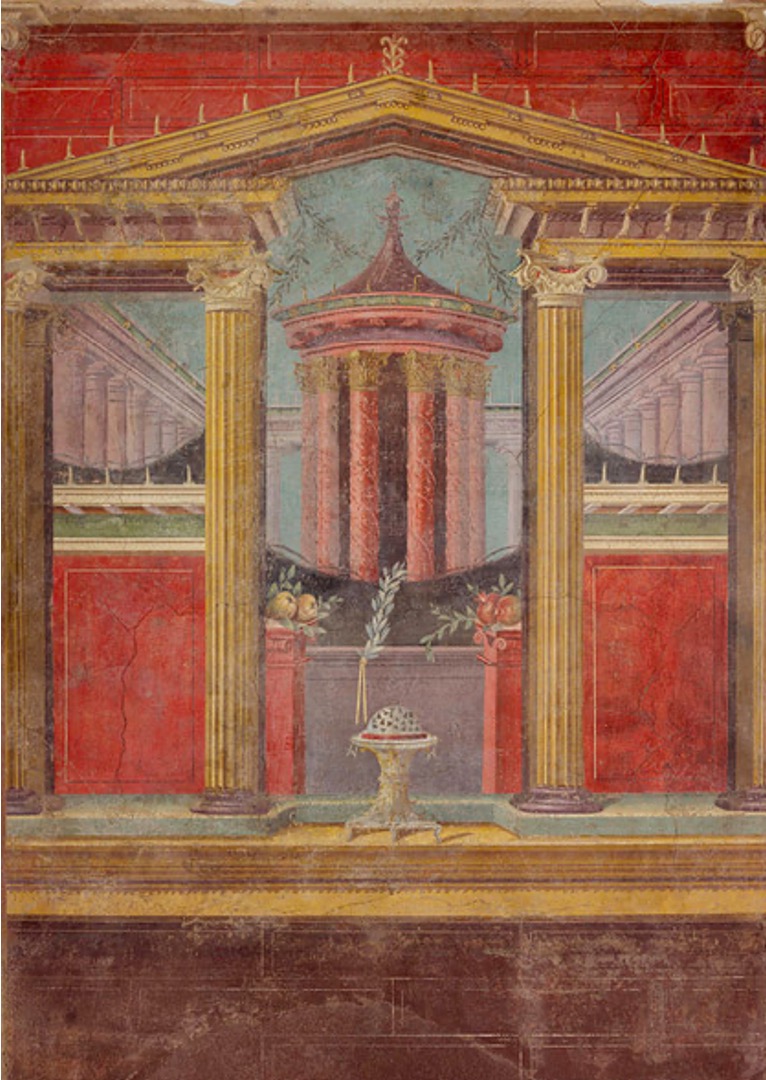
Boscoreale: Cubiculum, East wall- Alcove scene with tholos (Second Style), Republican,
ca. 50-40 BCE, side wall in the inner part of the room, small circular building, colonnaded courtyard is seen between the columns of a Corinthian propylon, pomegranates, single vanishing point- unusual for Roman paintings, laurel garland emerges from the temple and the offerings of quinces and apples on the entry gate perhaps allude to the villa’s crops or the general fertility of the land
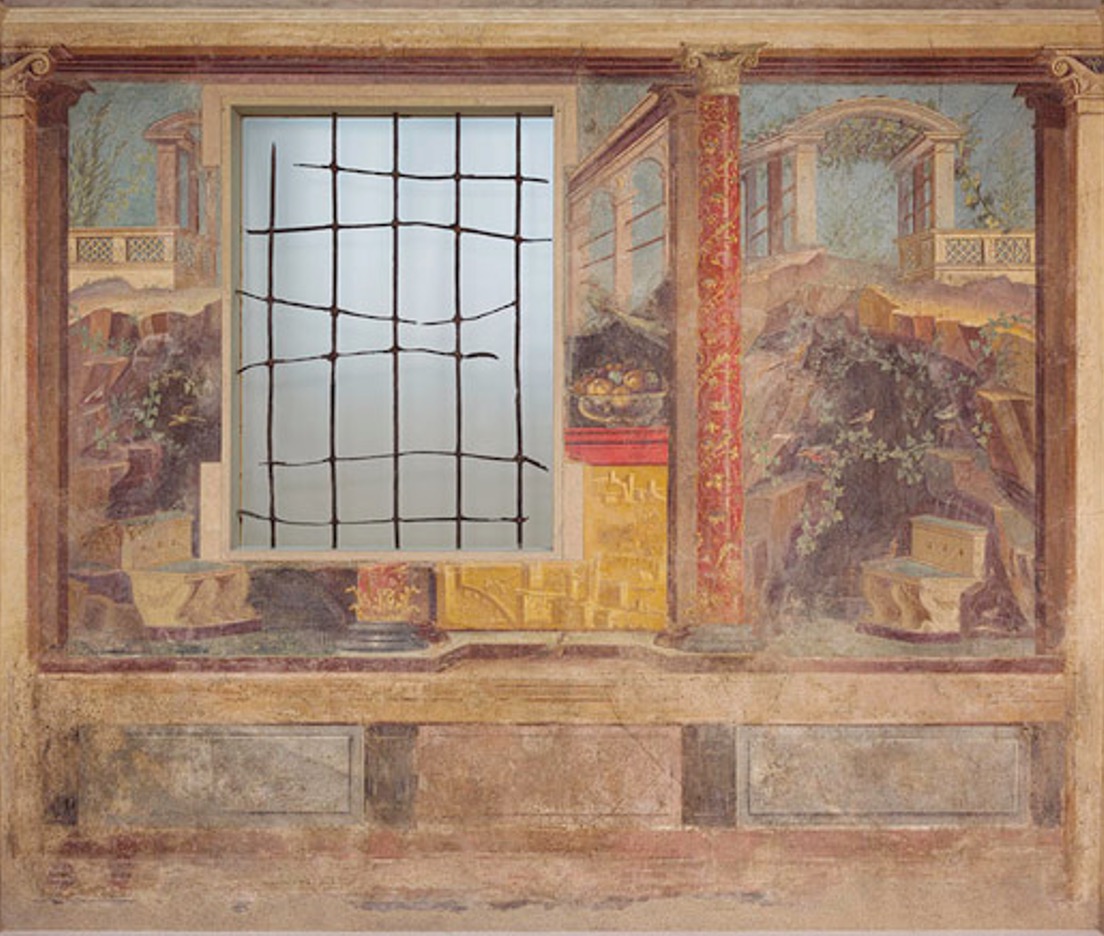
Boscoreale: Cubiculum, Back wall (Second Style), Republican,
ca. 50-40 BCE, rocky terrain with balustrades and a pergola above, a small cave or grotto sheltering a fountain, and a small figure of Hekate below, fruit bowl- second style included many little props/details, very nature focused scene
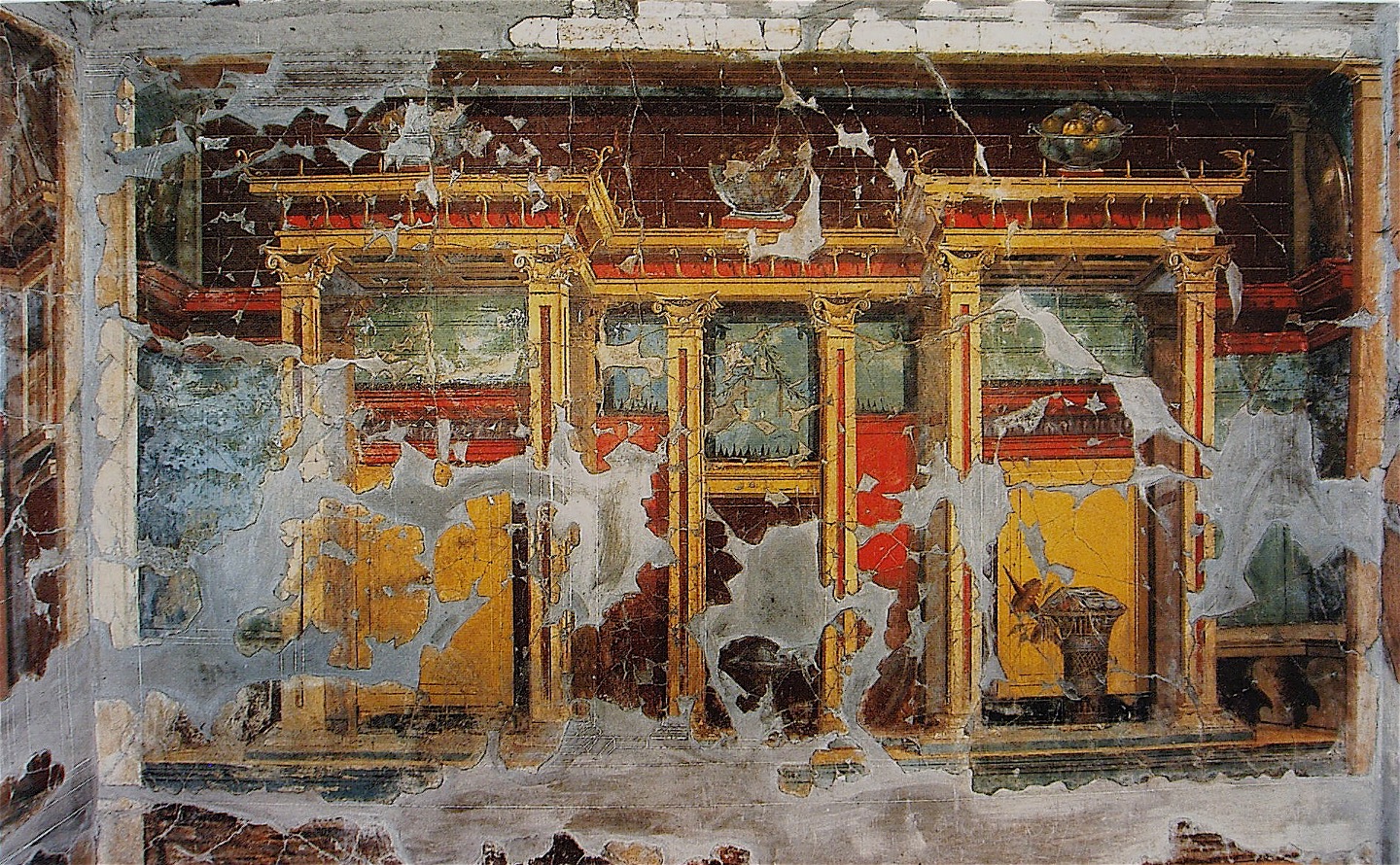
Oplontis, Villa of Poppaea: Diaeta- Side Wall (Second Style), Republican, ca. 50 BCE, Roman wall paintings were probably done by workshops/ slaves, as there are patterns throughout, scenographic trompe l’oeil techniques of creating three-dimensional space and also allusion to the appearance of the stage

Oplontis, Villa of Poppaea: Triclinium(Second Style), Republican, ca. 50 BCE, columnae caelatae, golden column shafts adorned with vine tendrils and red and blue gemstones with capitals with male heads, second style begins to include a lot of fantastical elements, Behind this fictive gate rises a tholos with a conical roof. Inside it we can make out a statue of the goddess Juno with a diadem on her head and beyond the temple the internal portico of the sanctuary.
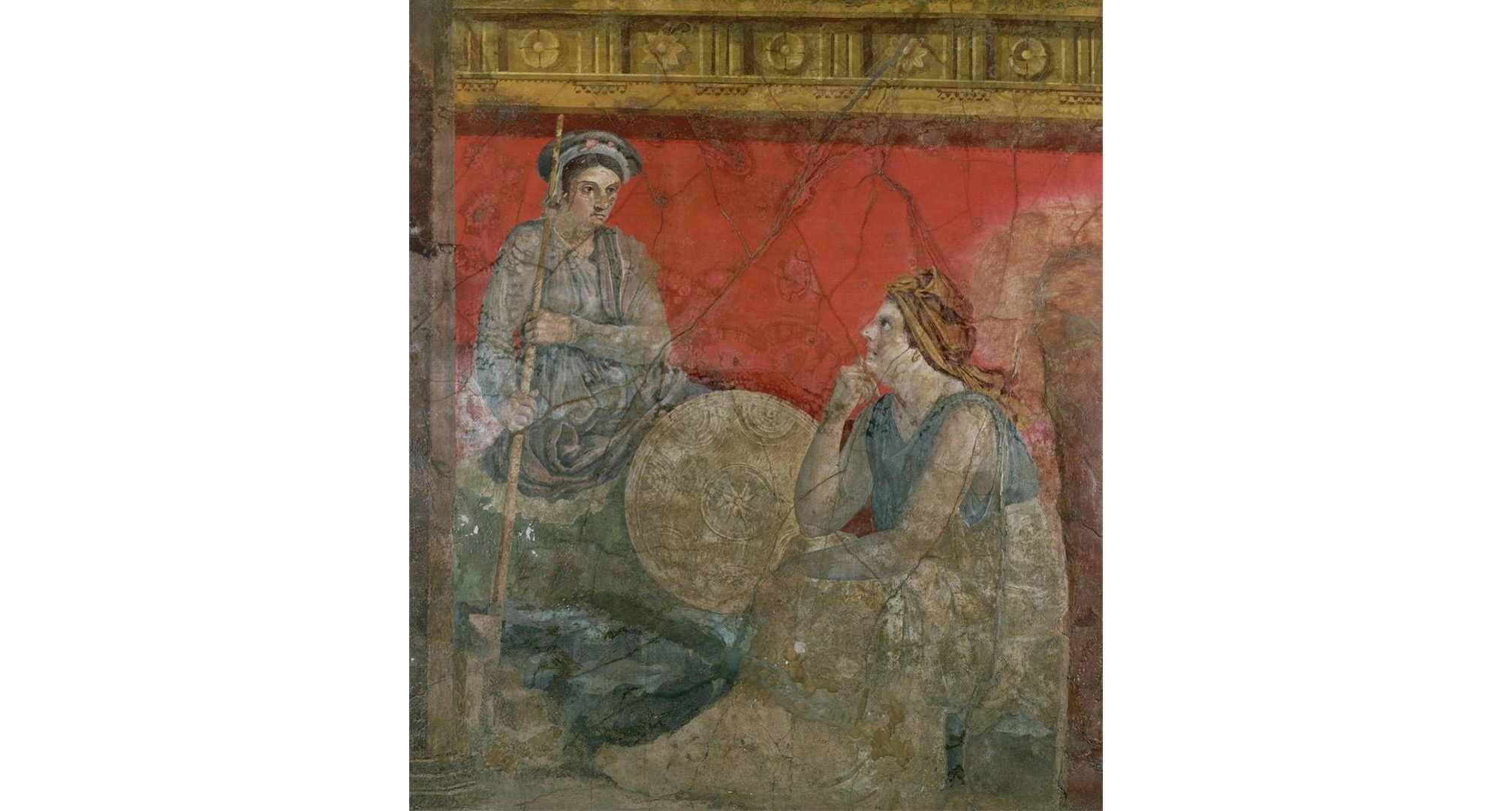
Boscoreale: Oecus- Macedonia and Asia (Second Style), Republican, ca. 50-40 BCE, room opened off the peristyle (the central feature of the house), life sized people painted, The large figures are generally thought to be copies or versions from a cycle of royal paintings created for one of the Macedonian courts of the early Hellenistic period. allegorical figures- Macedonia sitting on a rock, Asia sitting lower- showing Alexander the Great’s conquest of Asia (Persia)
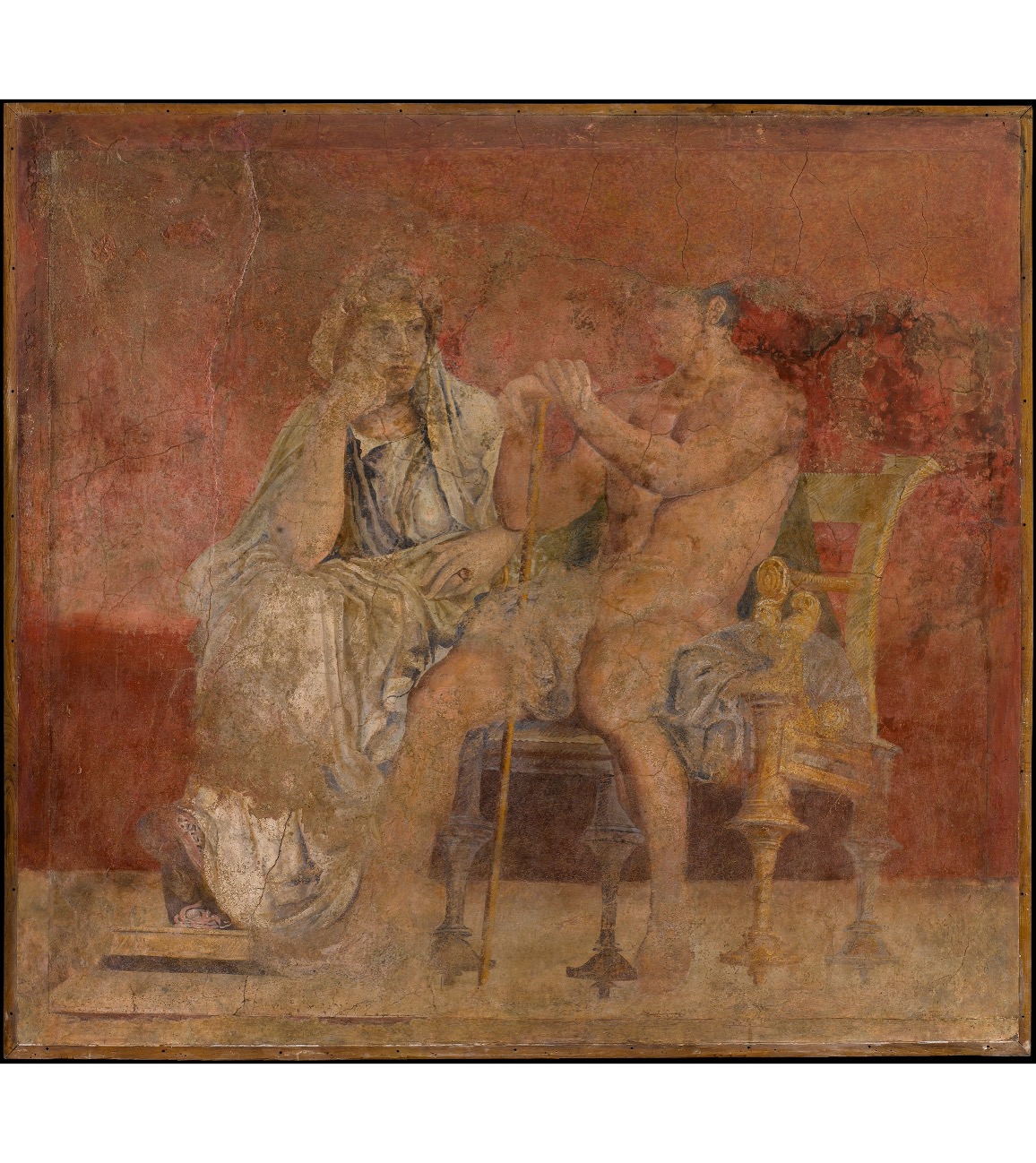
Boscoreale: Oecus- Seated Couple (Second Style), Republican, ca. 50-40 BCE, two figures wearing purple, most likely Alexander the Great and Statira, the Persian princess whom he married to symbolize the unification of the two kingdoms, magnificent multiple wedding of Alexander and his companions to daughters of the Achaemenid house and the Persian nobility, which took place at Susa in 324 BC
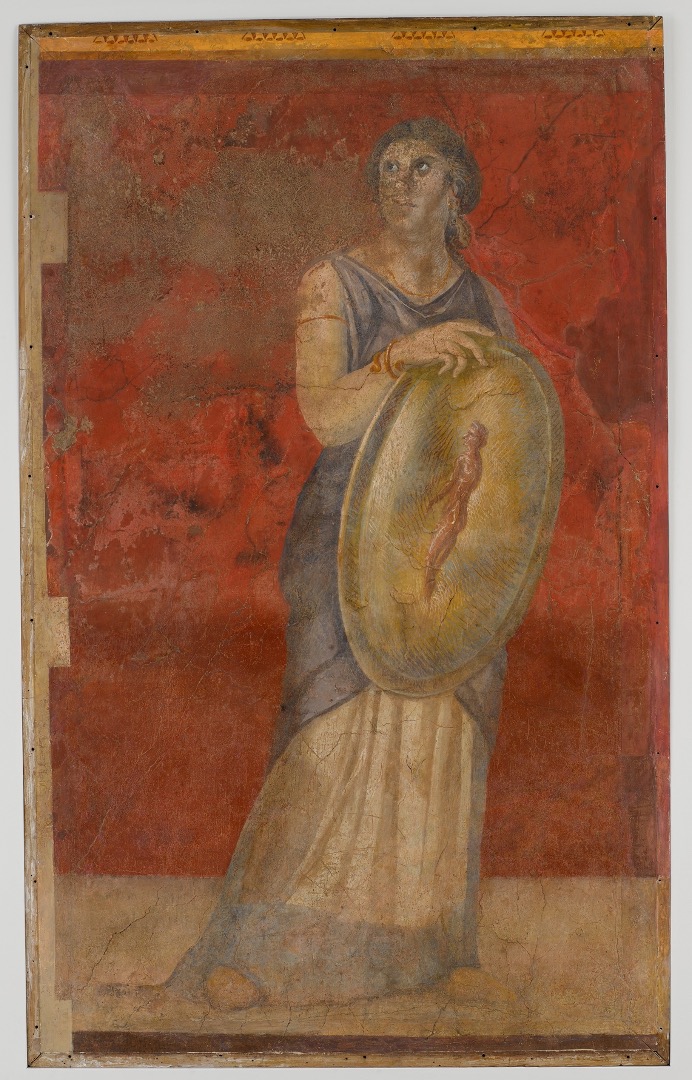
Boscoreale: Oecus- Shield-Bearer (Second Style), Republican, ca. 50-40 BCE, woman holding shield, The front of the shield shows the image of a standing nude male who is adorned with a white headband, the same as those worn by Hellenistic dynasts, likely meaning a prophetic vision in reflective surface,
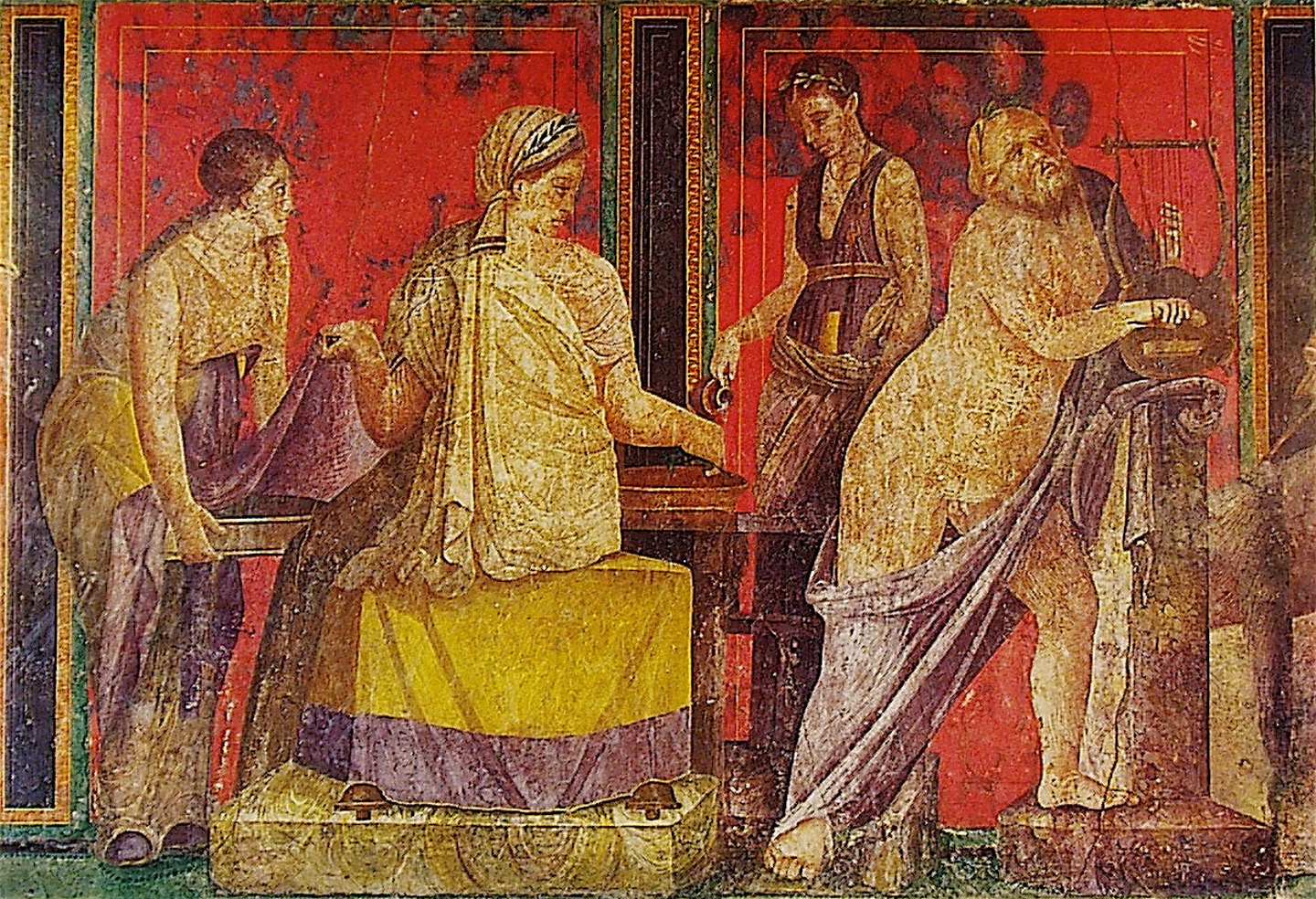
Pompeii, Villa of the Mysteries: Mystery Room- Scene of Sacrifice and Silenus(Second Style),
Republican, ca. 60-50 BCE, located just outside of Pompeii, known for this frieze, This continuous grand frieze depicting women taking part in a series of rituals associated with Dionysos is the first appearance of figure-paintings in Roman mural painting. both an initiation into the cult and initiation from girlhood to womanhood, owner might have been priestess of cult, owner could have been a prominent wine producer, transition from reality to magical subject
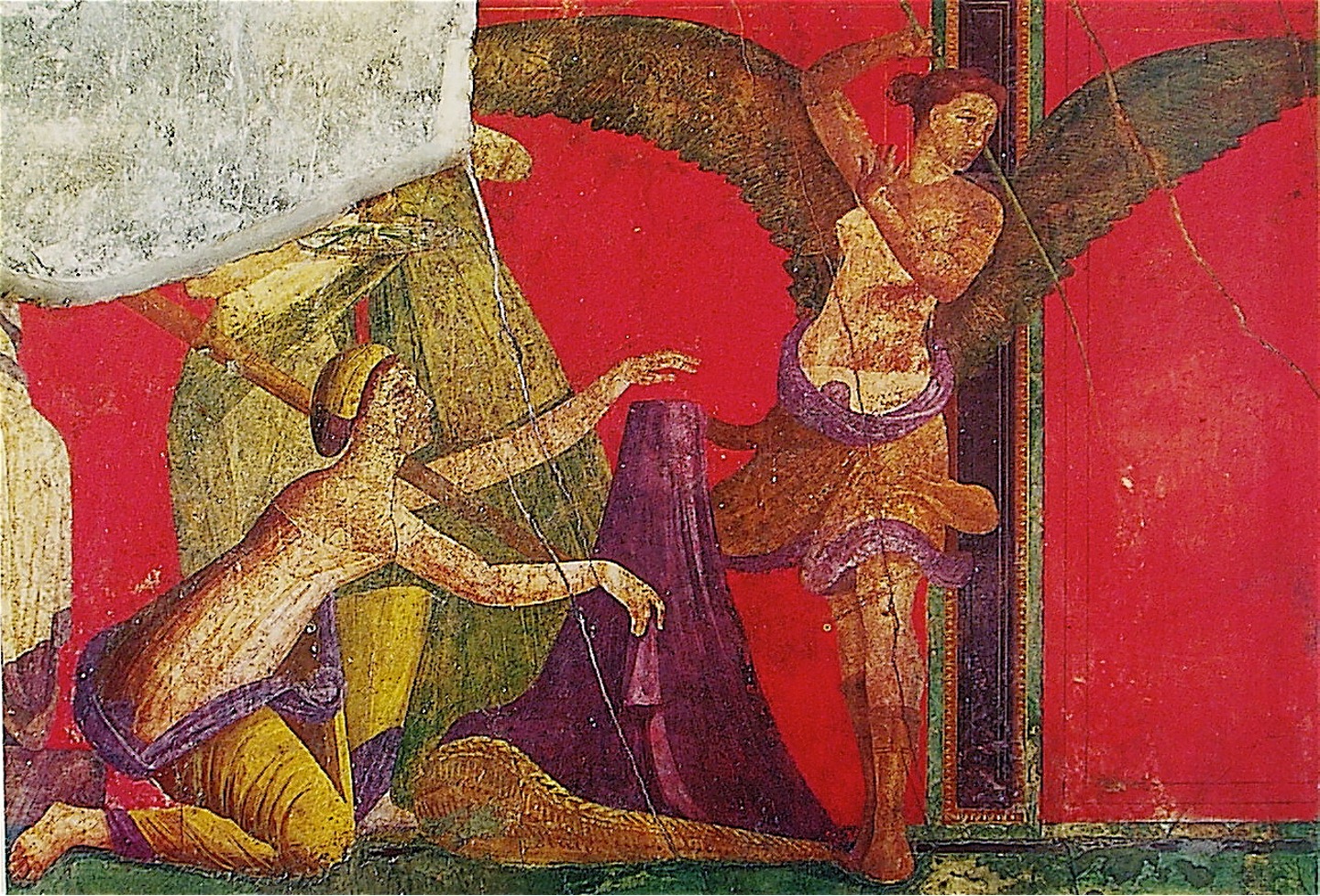
Pompeii, Villa of the Mysteries: Mystery Room- Revelation Scene and Lyssa(Second Style),
Republican, ca. 60-50 BCE, a half-kneeling, half-crouching woman, her hair gathered in a coif, prepares to lift the purple veil from a tall object standing in a winnowing basket (liknon). This was certainly a phallus, a symbol of regeneration, woman with wings-•Lyssa, a Dionysiac demon that whips up passions and puts people into a frenzy.
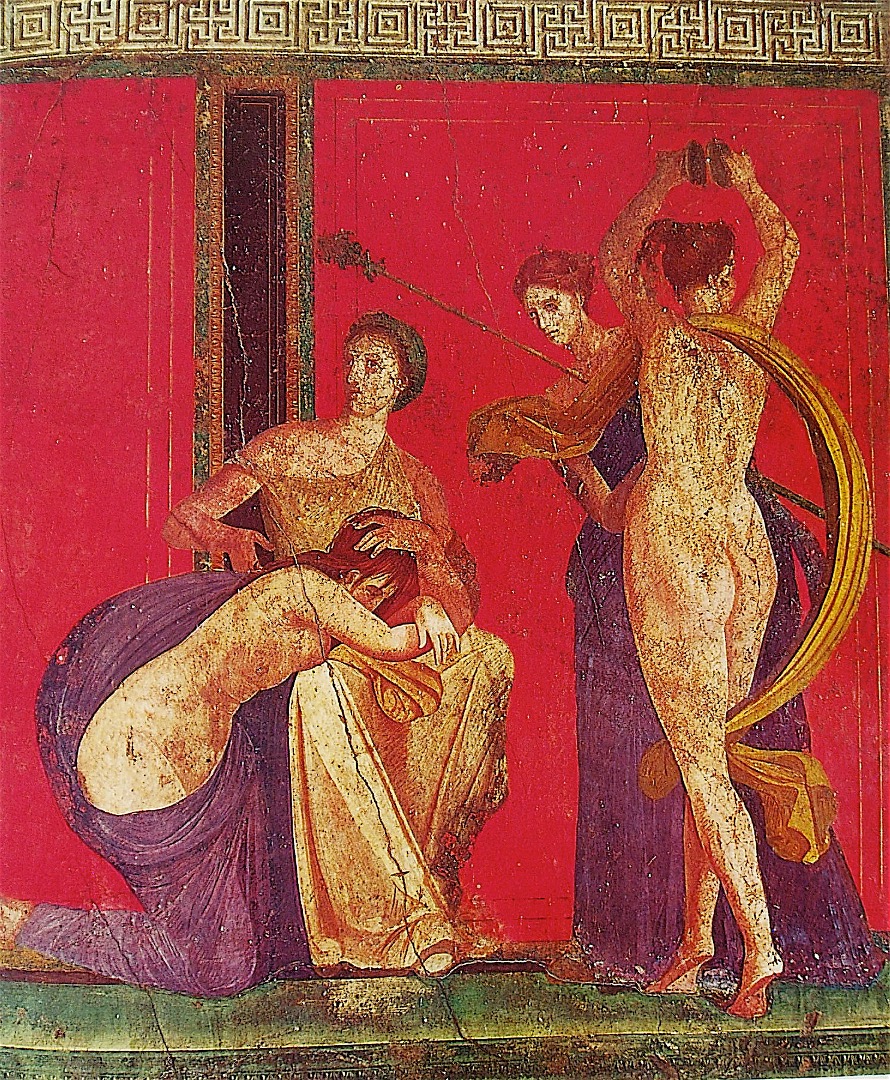
Pompeii, Villa of the Mysteries: Mystery Room- Scourged Girl and Dancer (Second Style),
Republican,
ca. 60-50 BCE, The young initiate buries her face in the lap of an older woman as she is scourged by the winged creature, depicted across the corner from her. In enduring the pain inflicted on her, she proves that she is an adult, ready for marriage. next to them is probably the initiate- nude and dancing